On this upcoming Friday evening, global attention will turn to the return of the world’s most popular football league, as the English Premier League 2024/2025 season restarts with a match between Manchester United and Fulham.
The English Premier League has now become a significant event attracting a diverse range of people, including fans and viewers seeking enjoyment, as well as analysts and coaches looking to learn about the various aspects of the game.
However, the behind-the-scene preparations must take place before the main event begins.
Therefore, the pre-season period is regarded as the final rehearsal, allowing for the testing of various ideas and ensuring that players become accustomed to and execute them to the best of their ability.
In this Premier League tactical analysis, we will discuss the key new ideas and tactics that some Premier League coaches have attempted to implement in set-pieces during the pre-season.
We will also address the advantages and disadvantages of each tactic, which can be modified to enhance them.
Liverpool FC Set Piece Analysis
Starting with Liverpool, who have advertised for a new set-piece coach, they have shown several interesting tactics during pre-season, which included set-piece tactics.
In the photo below, Man United defend with four zonal defenders in the six-yard, four man markers, a short-option defender and a rebound defender.
Liverpool’s targeted player is the yellow player who will be free from his marker with the help of his mate, who gives his back to the goal and is ready to block the targeted player’s marker, which is called a screen, which we will see later.
The targeted area is the area in front of the near post on the edge of the six-yard line, so the green player goes from the blind side to block the zonal defender there while the two orange players go to chase the ball if the cross is weak.
This may also help drag this zonal defender a few steps forward to empty the area for the yellow player.
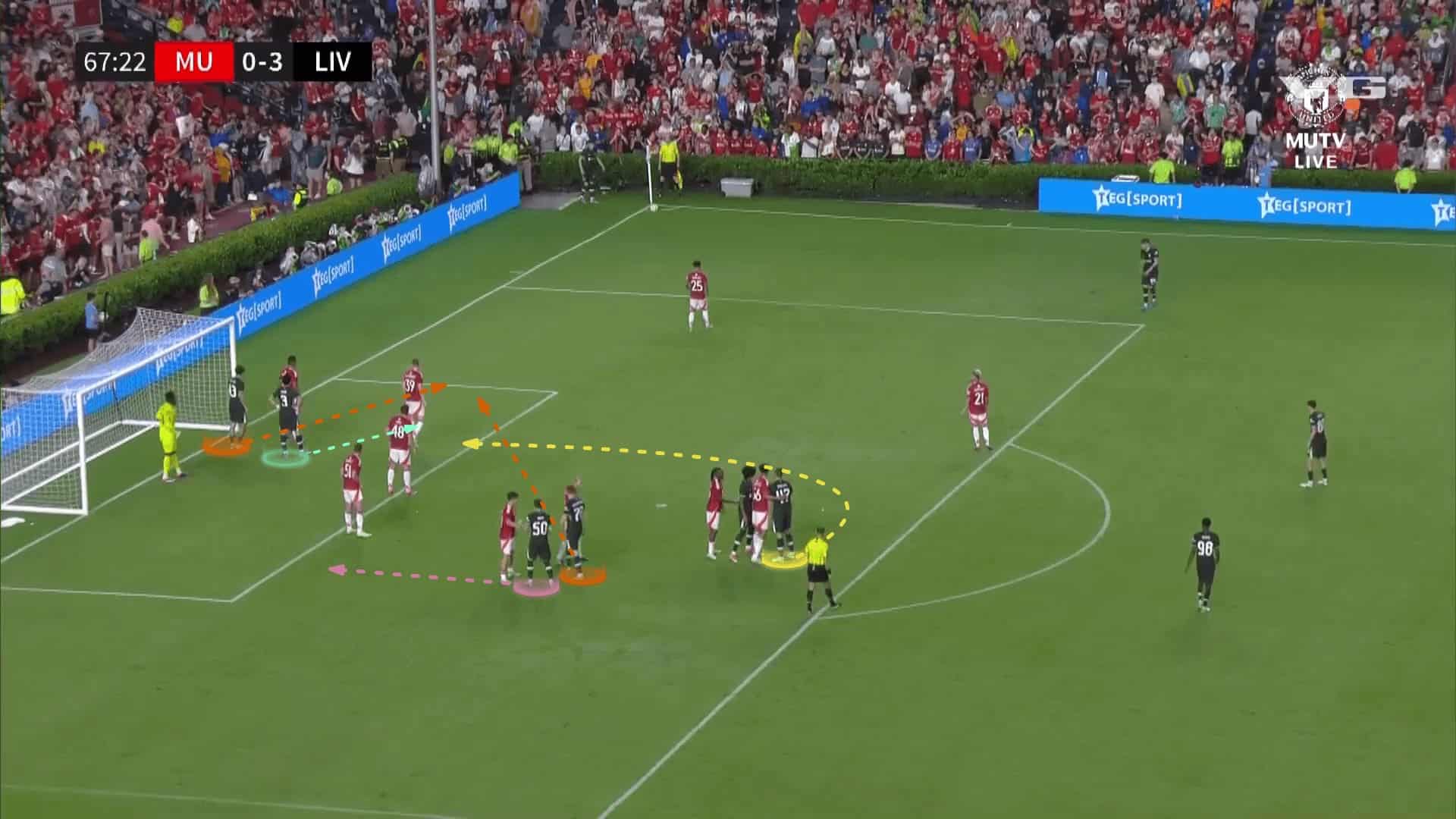
Here, the screen is clear while the pink player goes to the far post to frame the goal in case the first targeted player flicks the ball or the goalkeeper saves it.
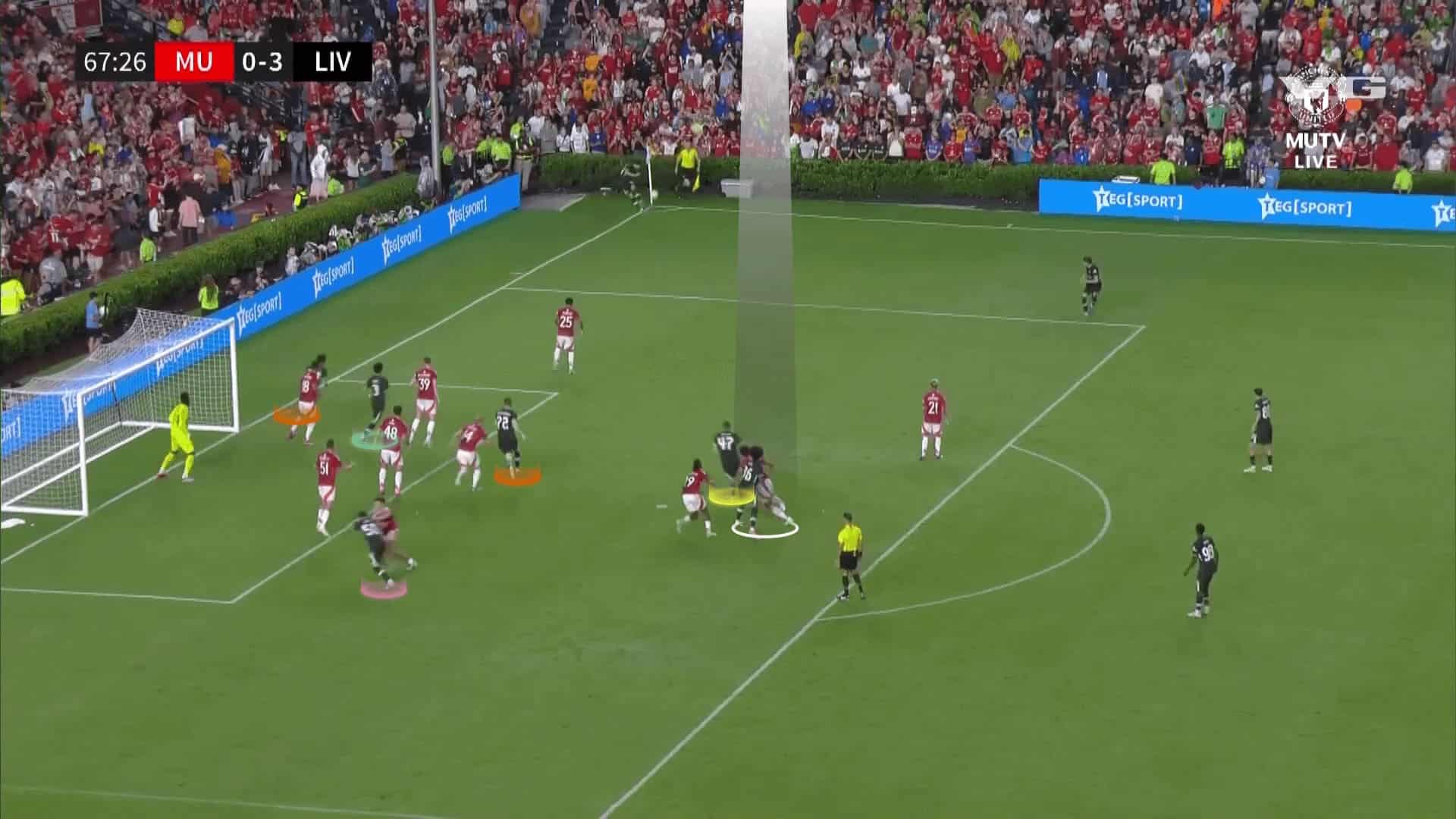
The plan works, and the result is a dangerous chance, as in the two following photos.
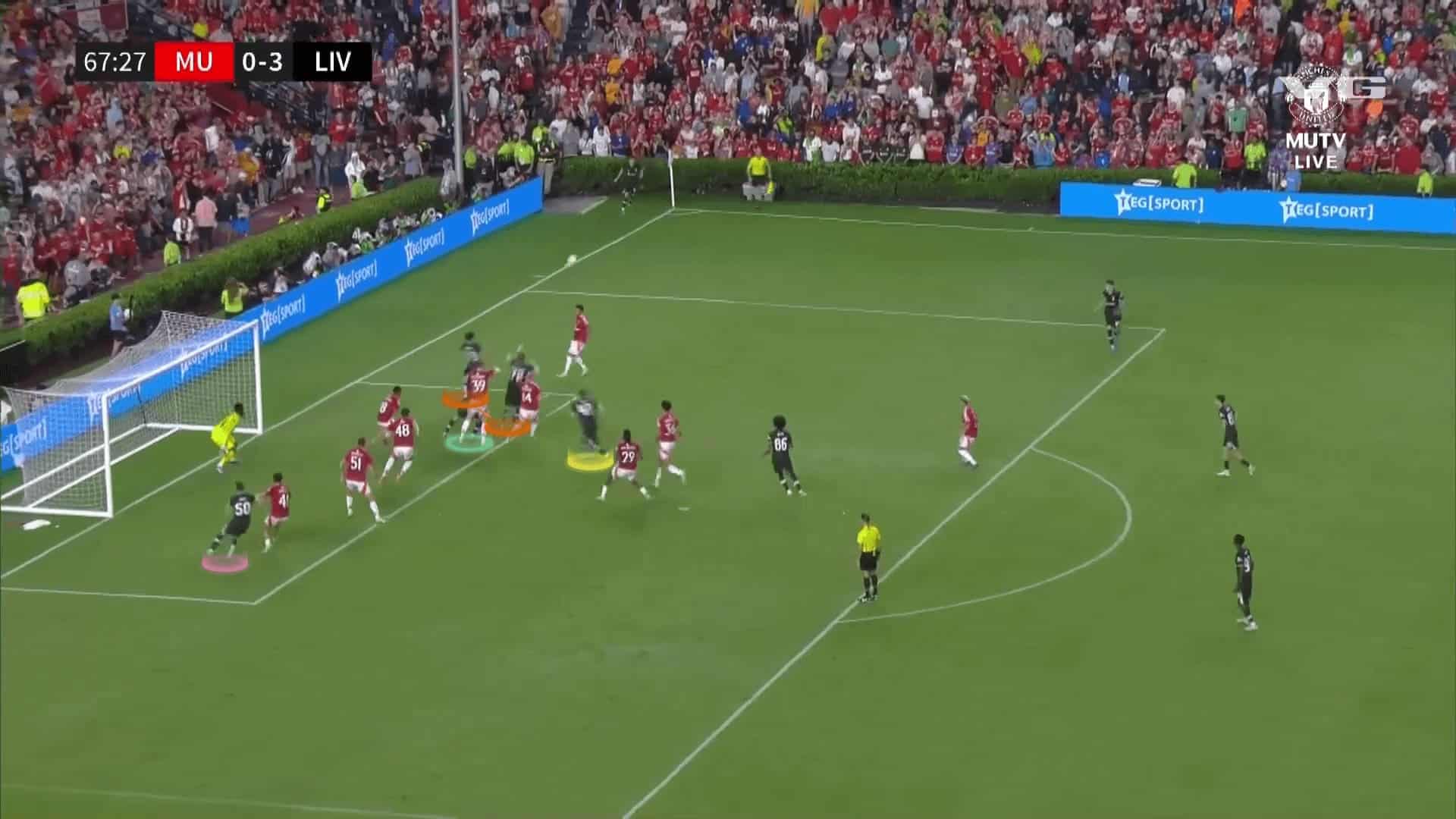
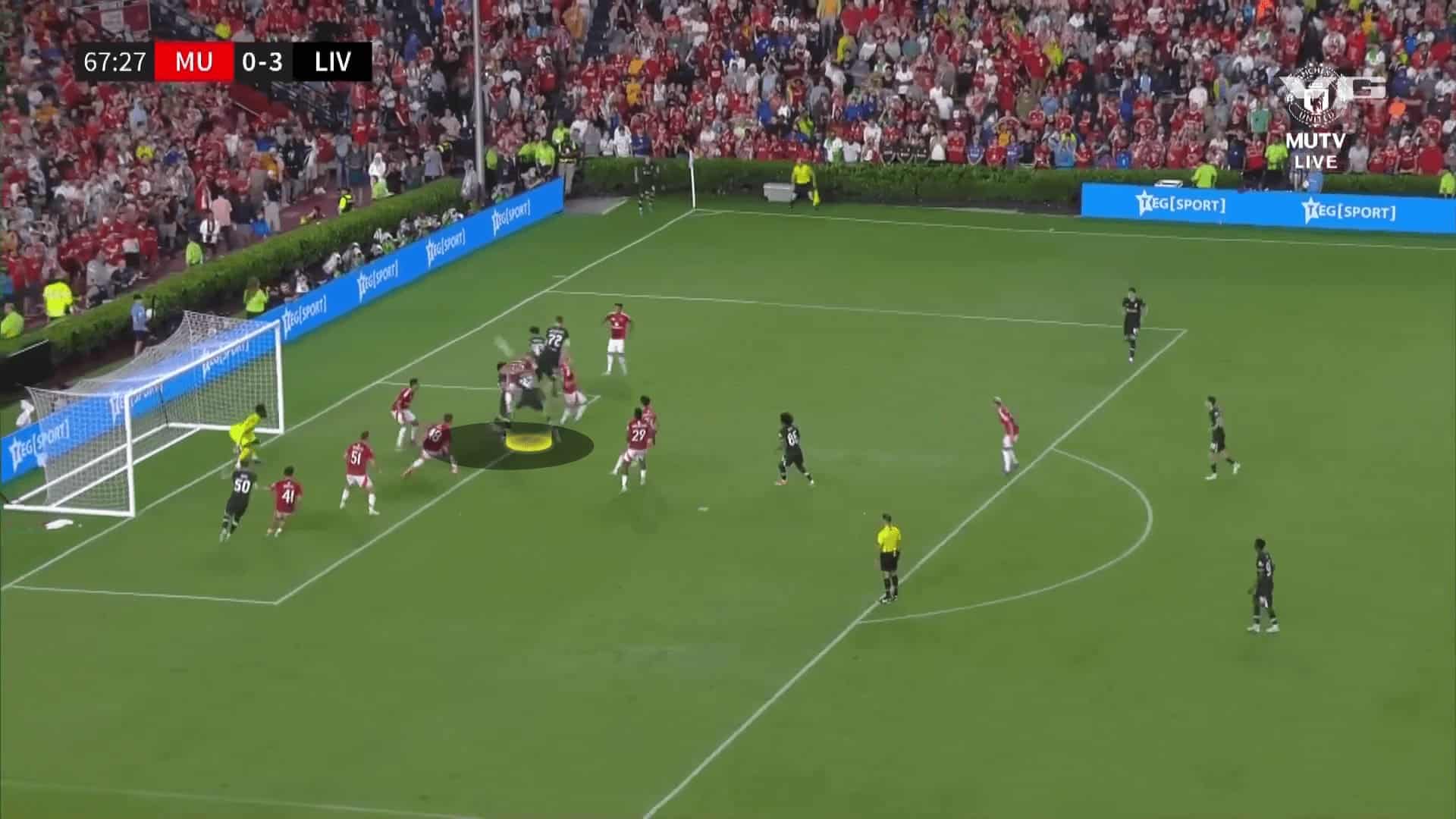
In another routine, all nine players stand initially in a pack.
Then, everyone starts to move to their assigned area, but what is the point?
Starting in a far pack in the far-post side puts you on the blind side of the zonal defenders, who can’t track them and the ball at the same time.
They can also manipulate the markers, who usually wait and don’t start with attackers outside the box, through strange long paths.
In the photo below, Arsenal defend with three zonal defenders, five awaiting man markers and two players standing on the edge of the box.
Liverpool’s first three players, in green, go to stand on the edge of the box for the rebound while the orange player runs outside in a curved path to attract the attention of the man markers.
The two white players go to the targeted area through different paths, so there are still three players standing on the far post. Let’s track them in the next photo.
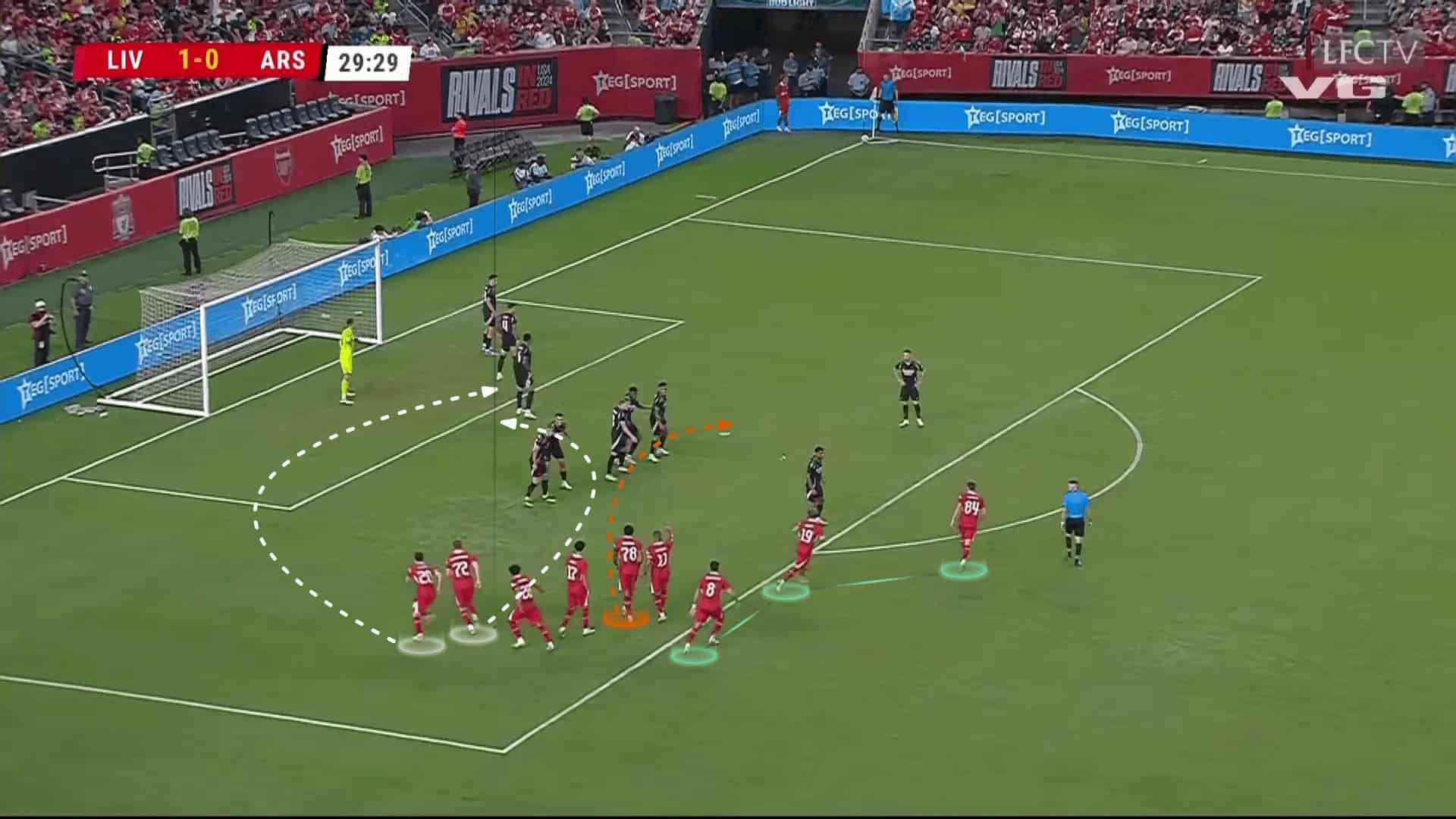
In the photo below, you can see the white players come from the zonal defenders’ blind side, while the orange attacker attracts the attention of three man markers who anticipate that other attackers will come toward the near post.
Thus, the three attackers on the far post have only one marker, in pink, while the other two are free.
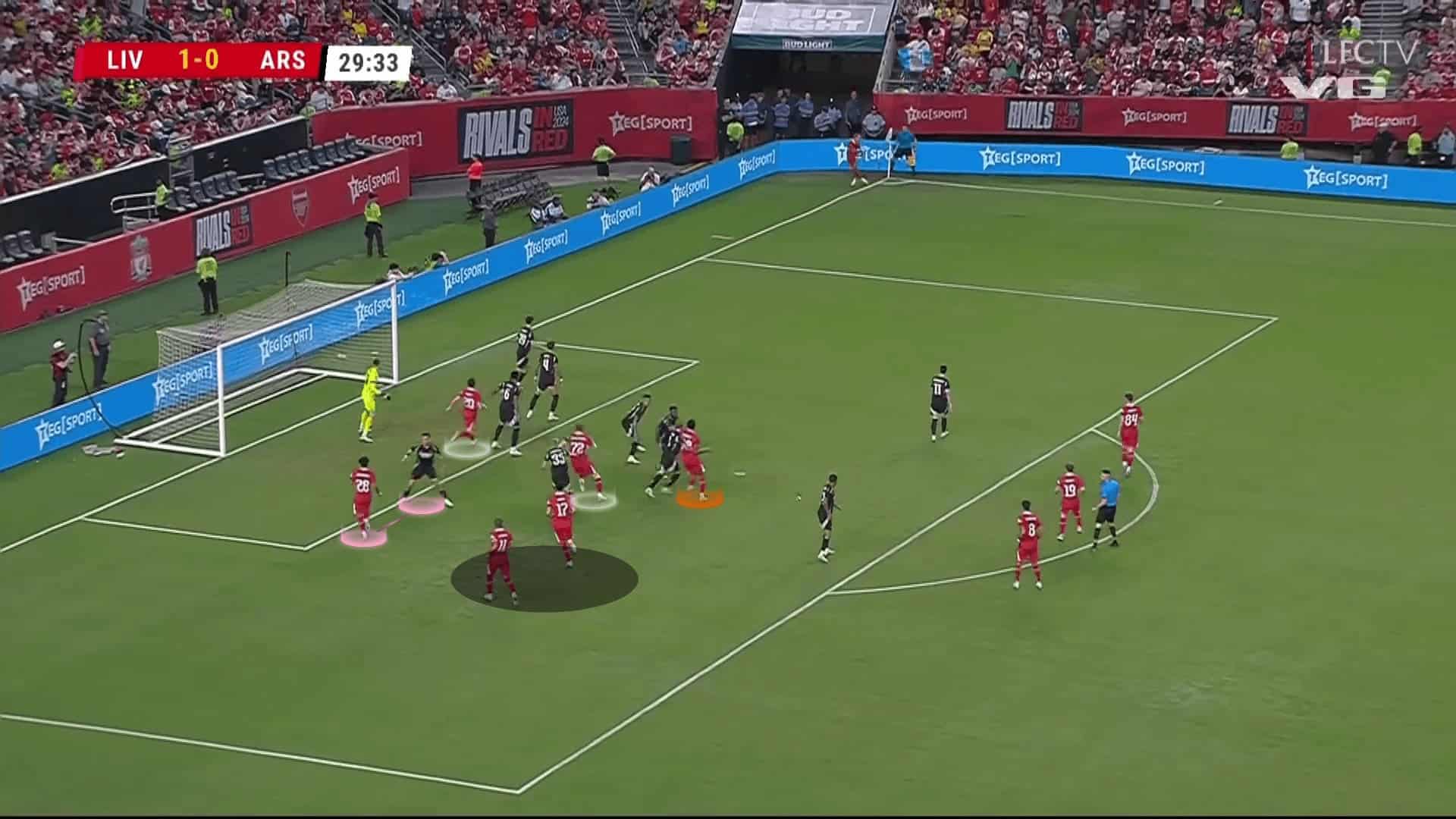
The plan works, but the goalkeeper punches the ball.
We want to highlight that they can enhance this routine in many forms and exploit the free attackers, even if they aren’t the best in heading.
That also could happen if anyone manages to flick the ball.
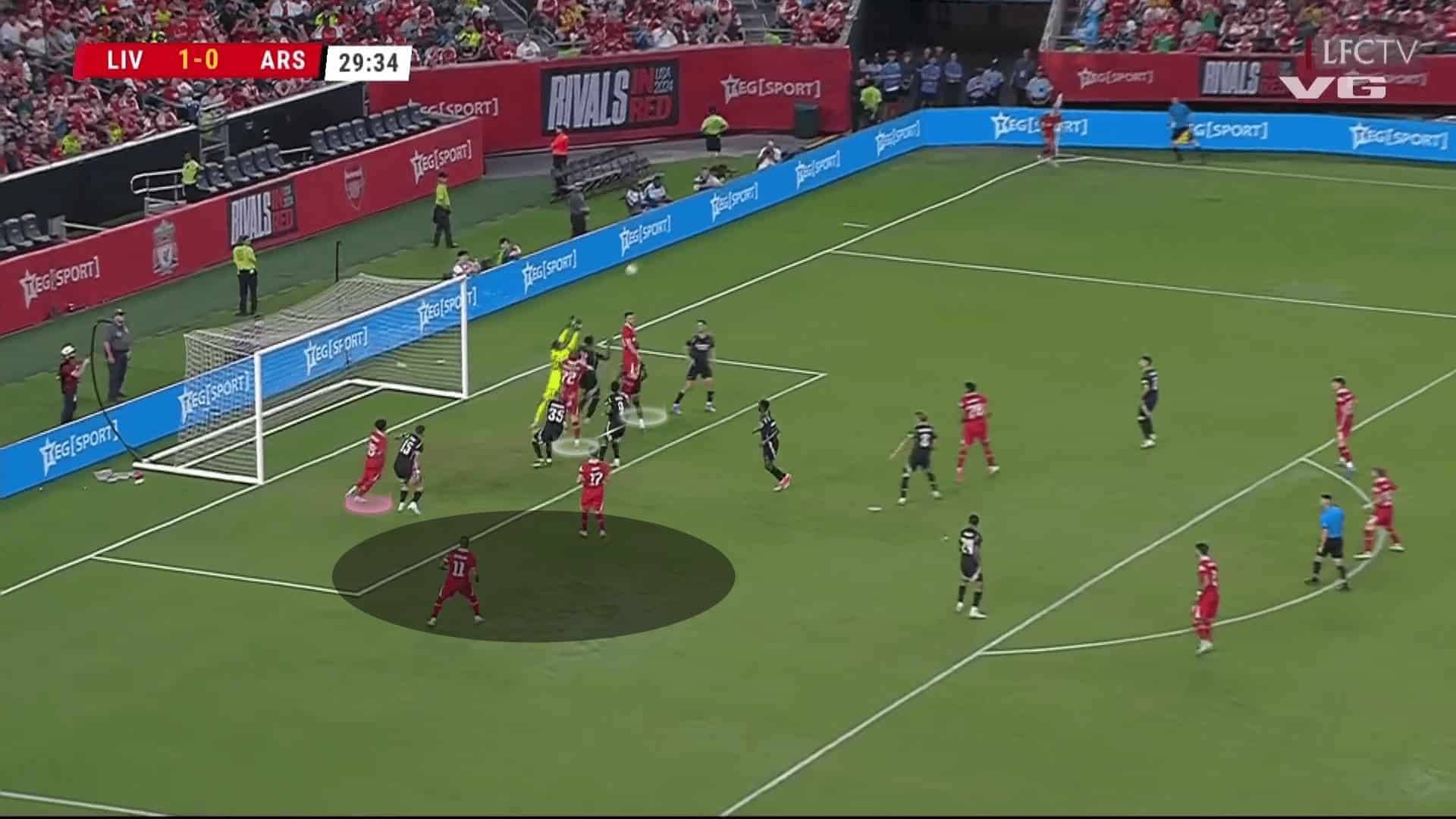
Going to free-kicks, they have tried to exploit an off-side player to block a defender from his back to free the path of the targeted player who penetrates from a further point.
In the photo below, the targeted player wants to take the arrowed path, but he should be free at first, so Arne Slot’s side puts another white player to run a disguise run to drag the one that Arsenal put to block runners.
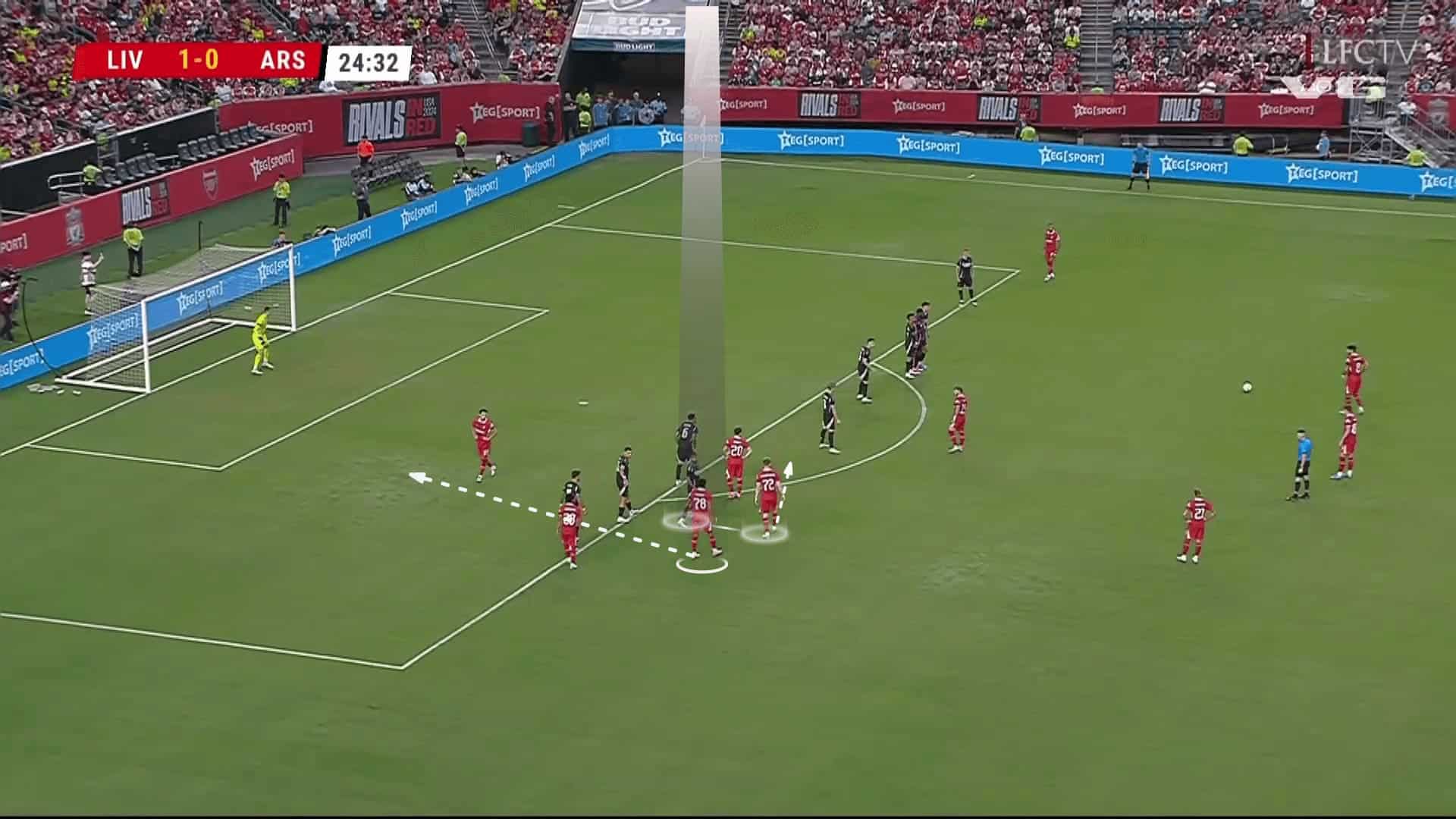
Now, we should secure the path itself by blocking the two players in the defending line.
Here, the off-side player comes in, so he suddenly comes from the defender’s back to block him while the last attacker turns around the last defender for the same purpose.
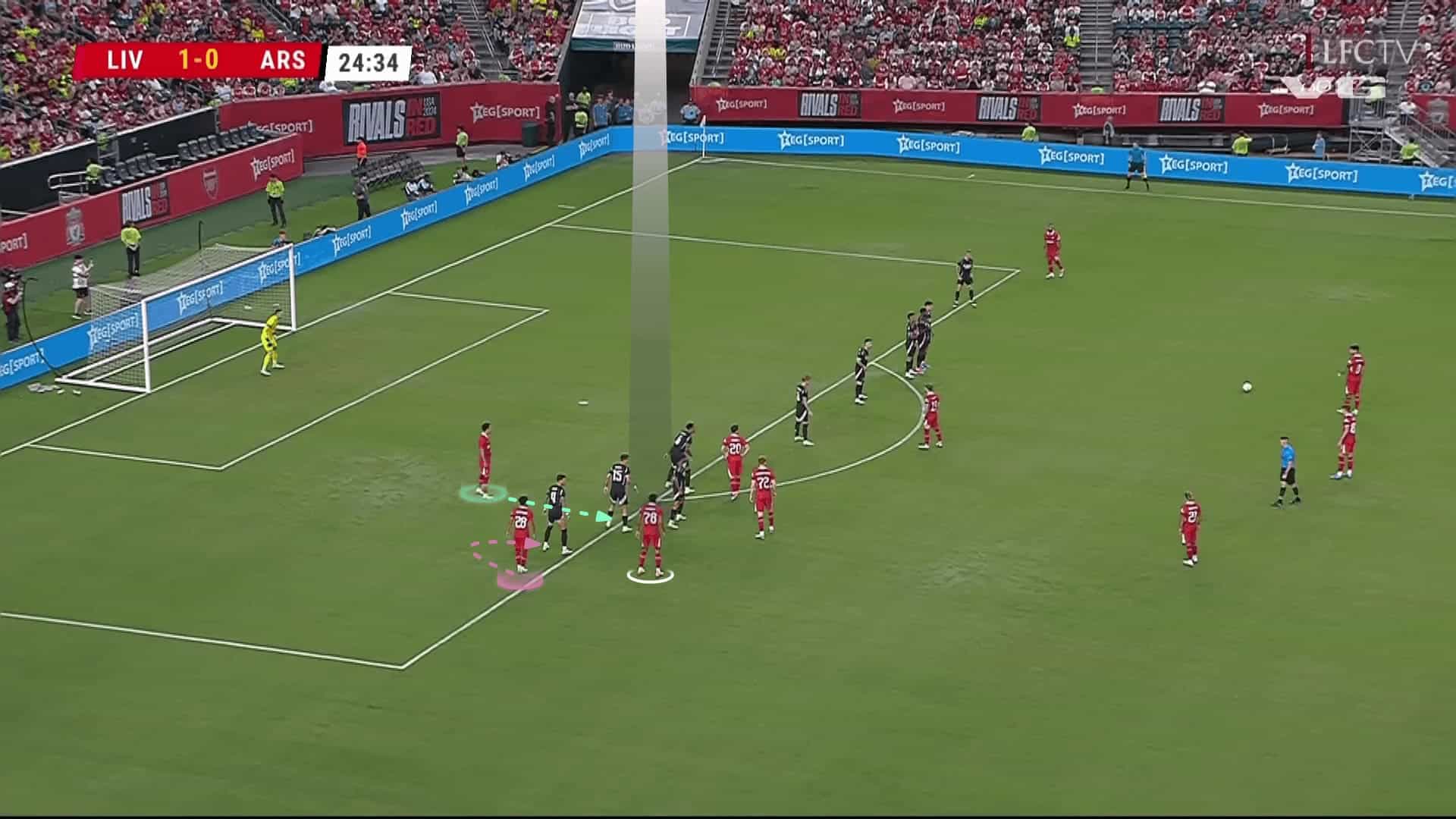
The plan works, and we have the two defenders blocked, but the cross is overhit.
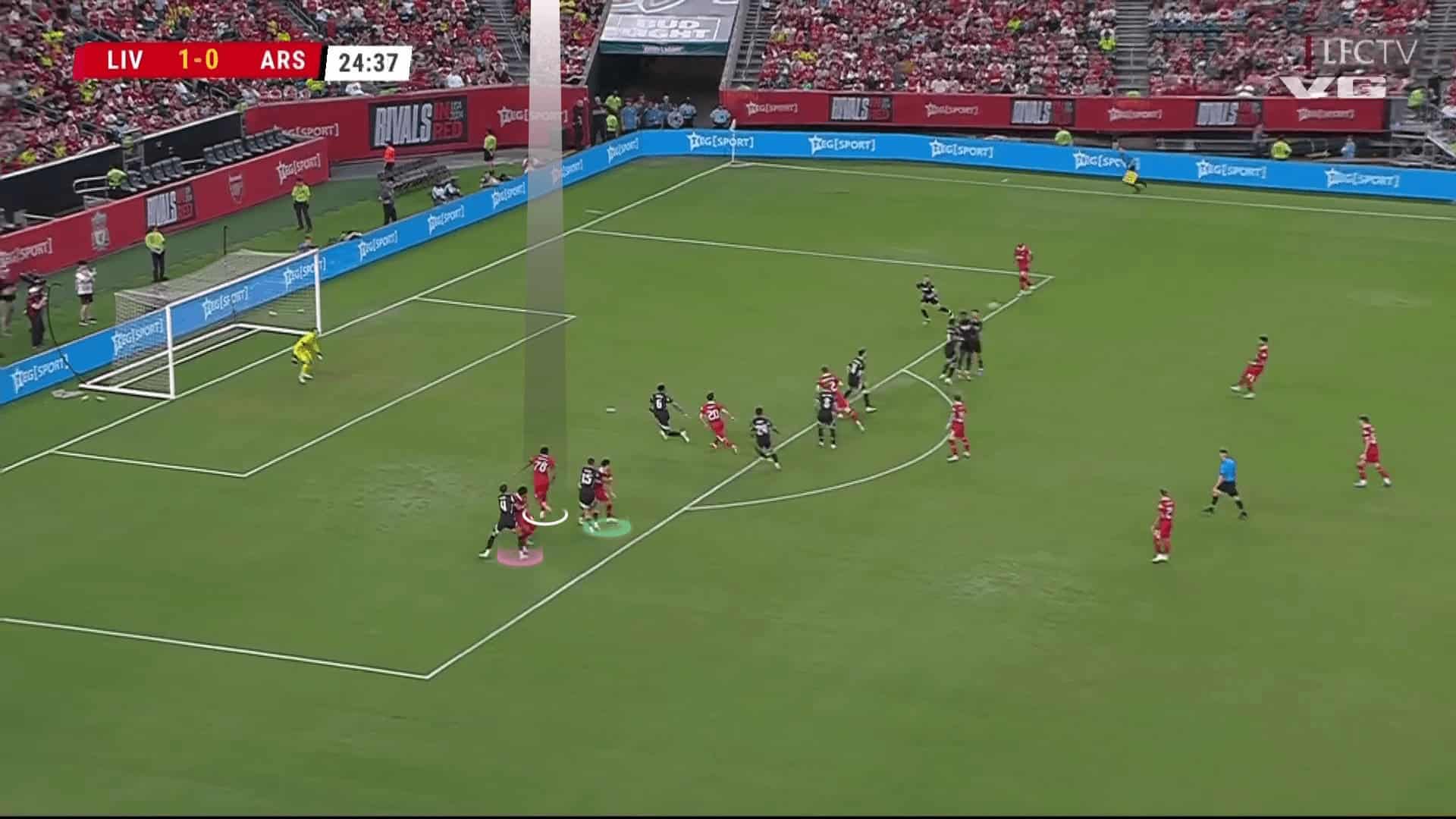
Arsenal Set Piece Analysis
You may be surprised to find the Gunners here because they were impressive last season and don’t need changes, but you missed an important principle in set pieces: the importance of variations being unexpected.
Before we start our journey, we need to focus on three things that we think the variations may come from them:
1- The taker from the left side
2- The one who blocks the goalkeeper, still Ben White?!
3- Gabriel Magalhães’ starting position.
In the photo below, William Saliba blocks the goalkeeper, not Ben White, as a variation while he also doesn’t start beside the goalkeeper, starting normally close to the normal far-post back and then comes from the goalkeeper’s back who can’t track him and the ball at the same time.
This means that he will need less effort to block him without fouls because opponents and referees have become aware of Ben White’s annoyments so that this variation could help then.
This happens in most pre-season matches, using different players to block the goalkeeper from different starting positions.
So, let’s see if they will always keep that in the Premier League or just as a variation.
Gabriel Magalhães is the targeted player, and it seems that he won’t stand with the pack often but will be fixed in the middle near the penalty spot, as he has started to do many times in the last season.
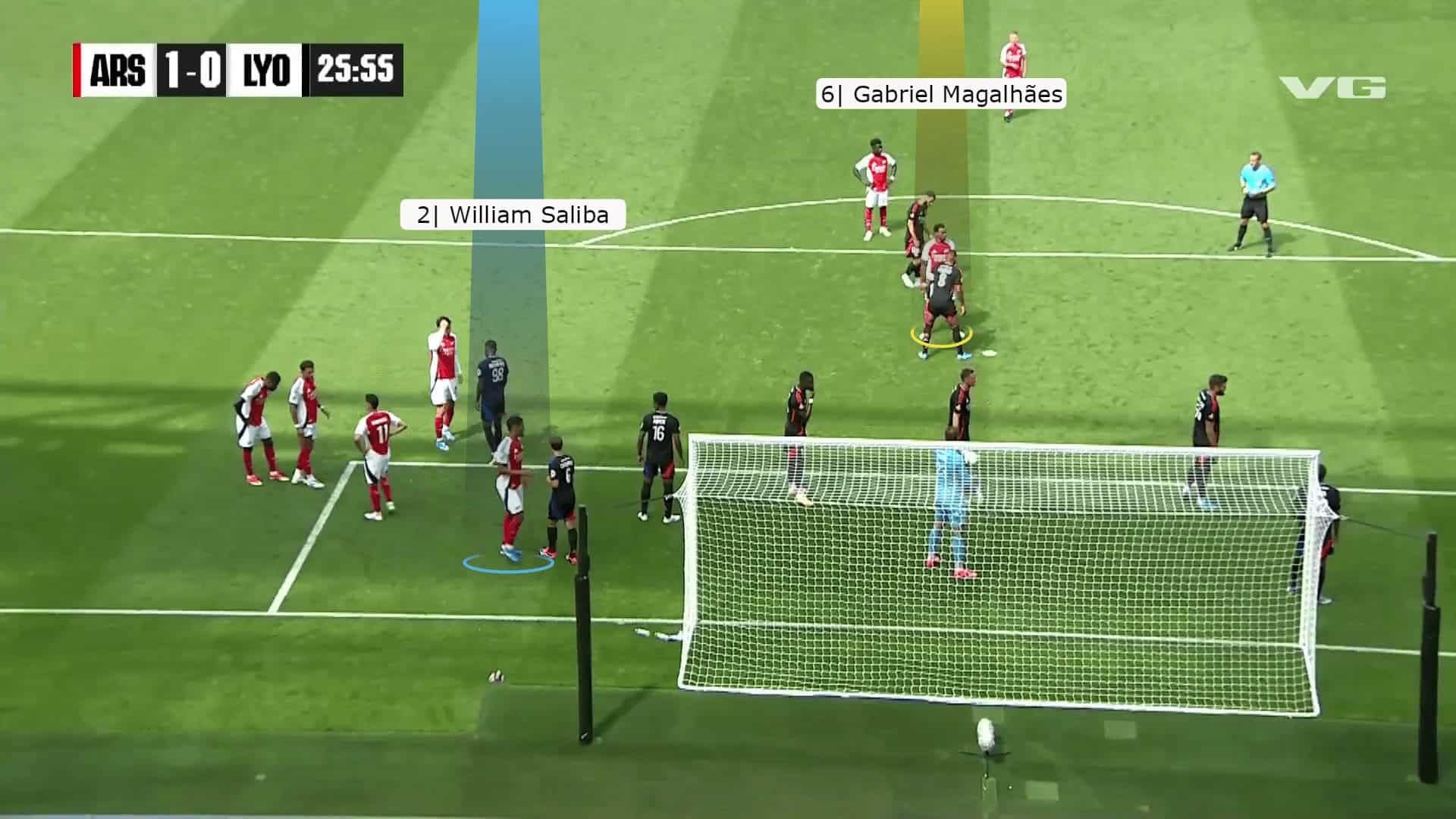
In the photo below, it seems that Declan Rice will be fixed as the left-side taker after showing great ability in crossing in the last season, even if Gabriel Martinelli is playing, which means that he will be a part of the six attackers who attack the box because Martin Ødegaard and Bukayo Saka stand on the edge of the box.
Oleksandr Zinchenko is behind them at the back.
It is easy to assign a role for Martinelli, in green, who is responsible for staying after the far post to frame the ball path if it passes the targeted player, Gabriel Magalhães.
Continuing the routine, the two pink players, Ben White and Thomas Partey block the last two zonal defenders while Gabriel, exploiting his starting positions, fakes a step toward the near post and then moves to the far post.
This forces the marker to turn around and give his back to the ball because he can’t keep tracking both at the same time, so he has to choose!
This is called an orientation problem.
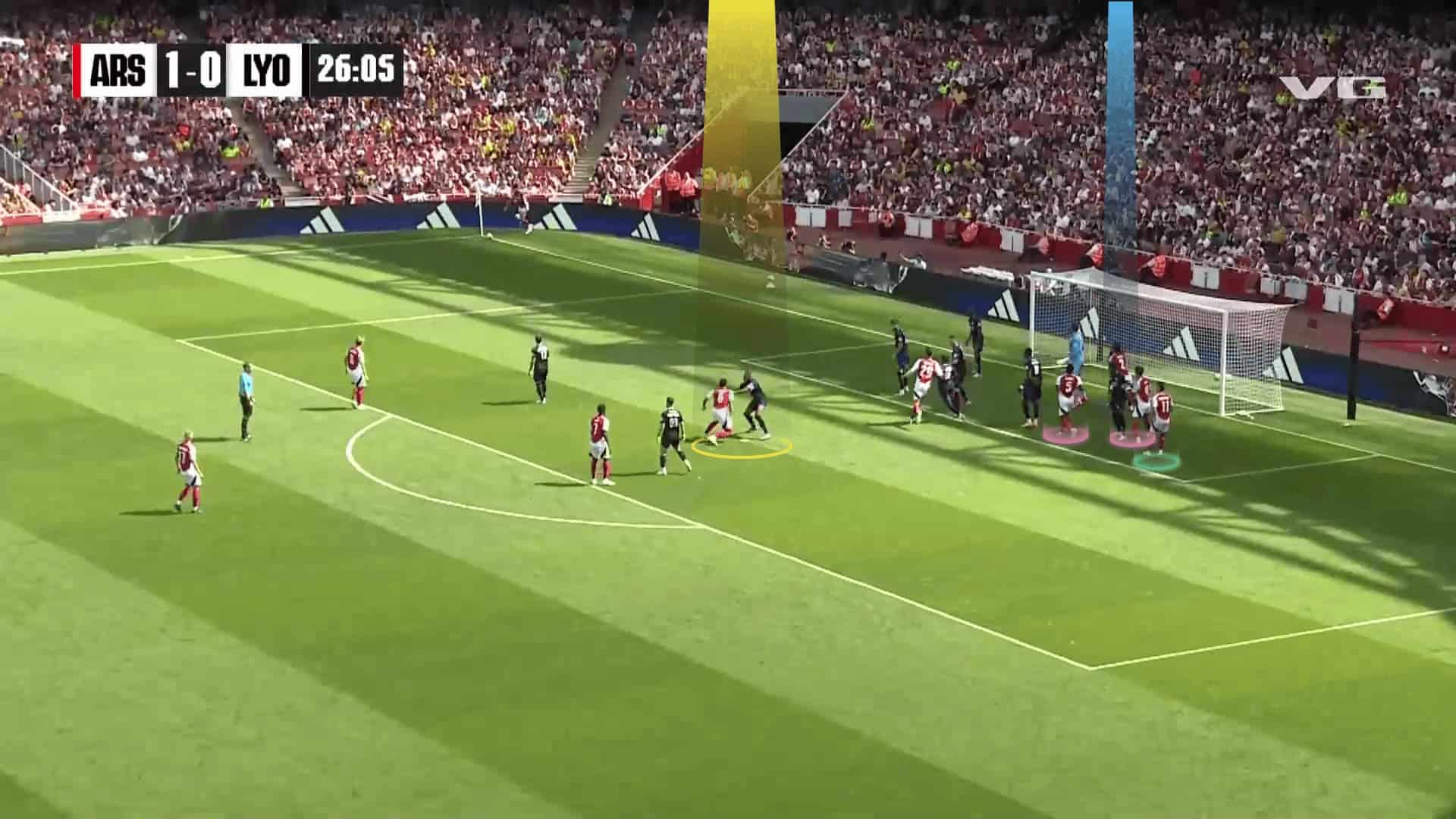
In the photo below, the orientation problem is clear, and this starting position gives Gabriel another advantage: having a long distance to run.
This means he will jump from movement so he can overcome anyone, which is called dynamic mismatch.
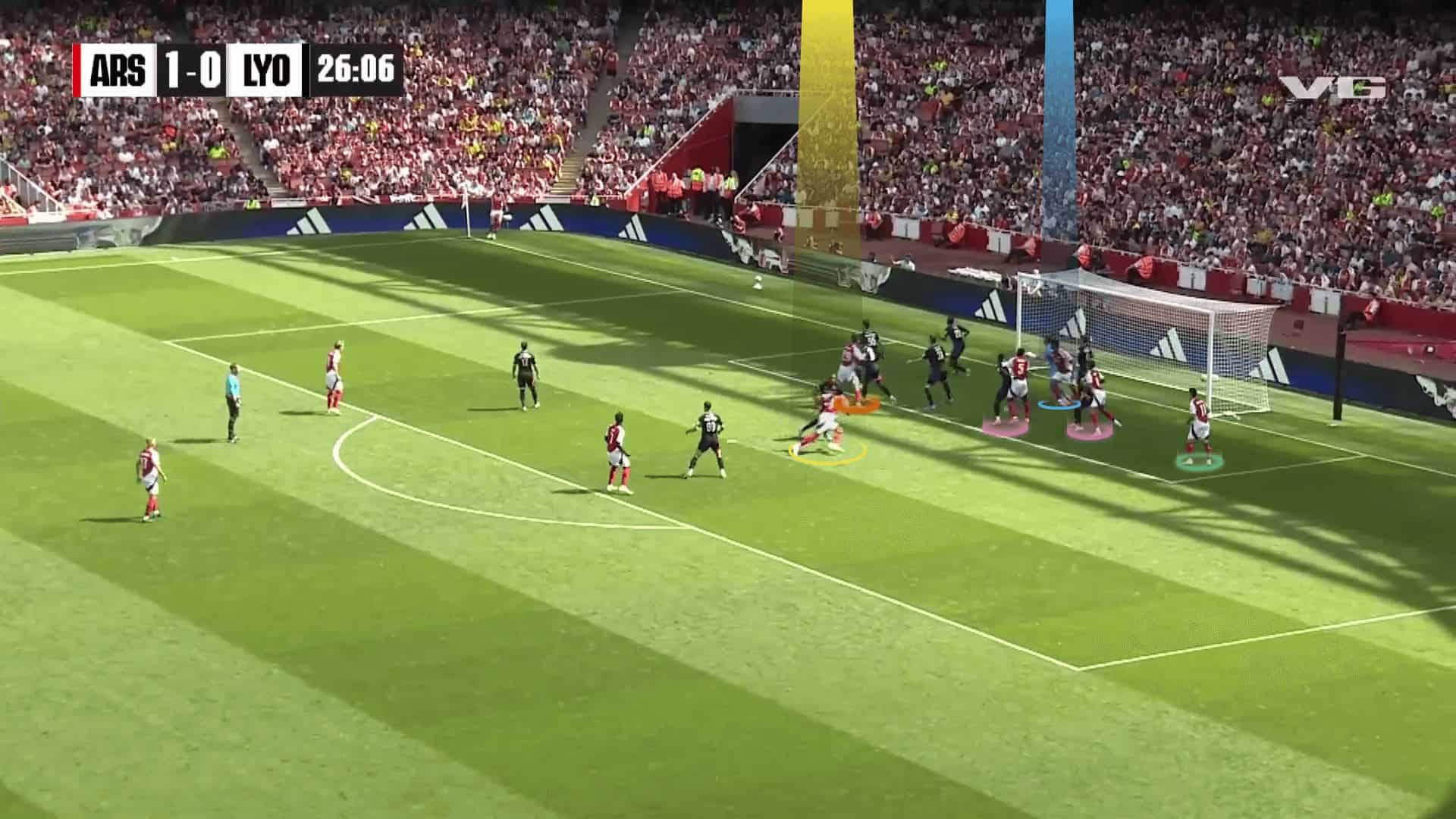
The plan works, and the result is a goal, as shown below.
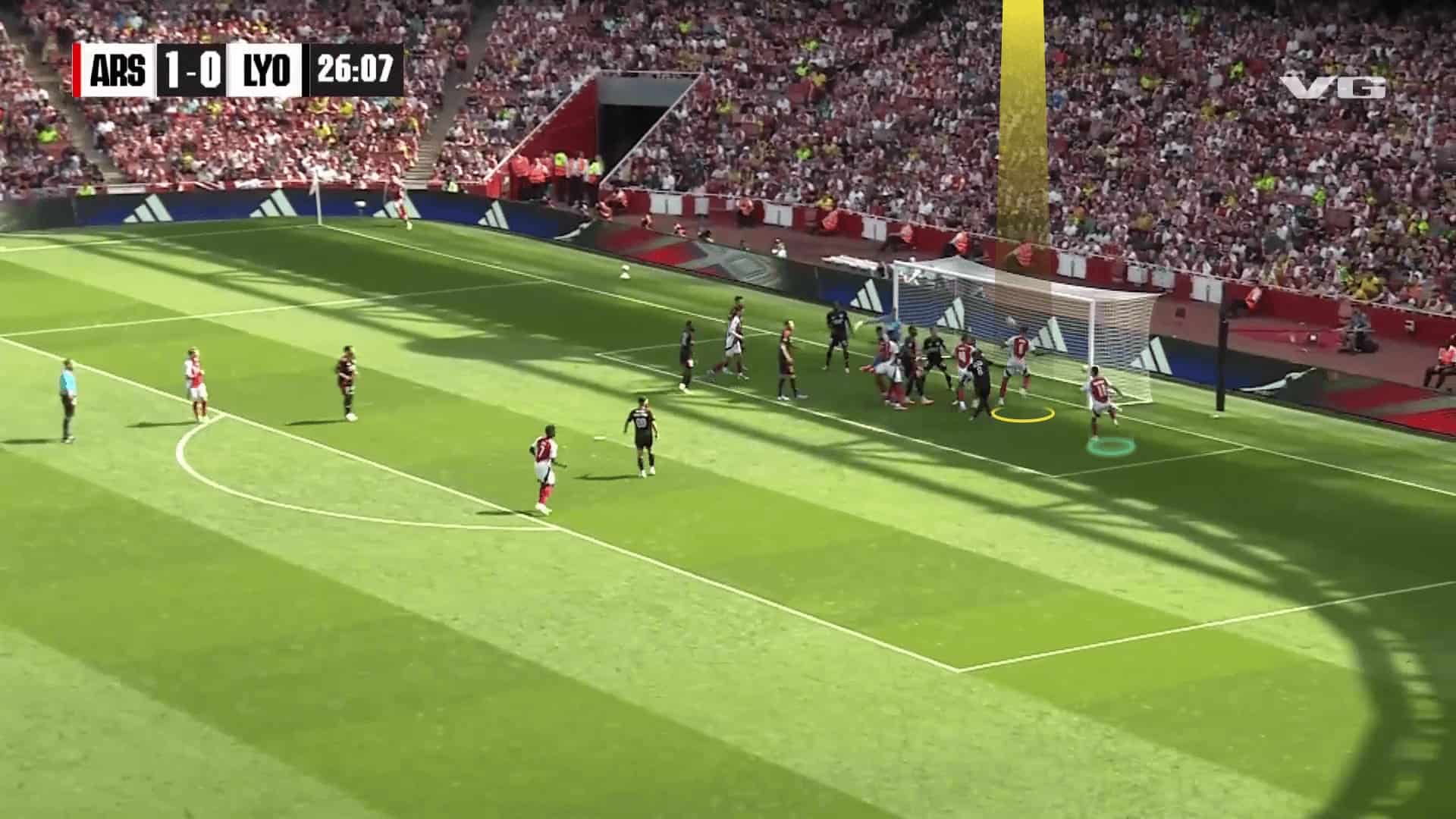
When it comes to targeting the near post, Martinelli’s role is similar to Ben White’s role, in green, which involves running to the area before the near post in different paths to drag the first two zonal defenders out of their positions and target the area behind them.
William Saliba, in blue, has the same role as blocking the goalkeeper and that continues in all corners in the match, starting with the pack and moving a bit before them while the other three attackers, including Gabriel, who now fakes a move to the far post and then goes to the near post, go to the targeted area from different areas.
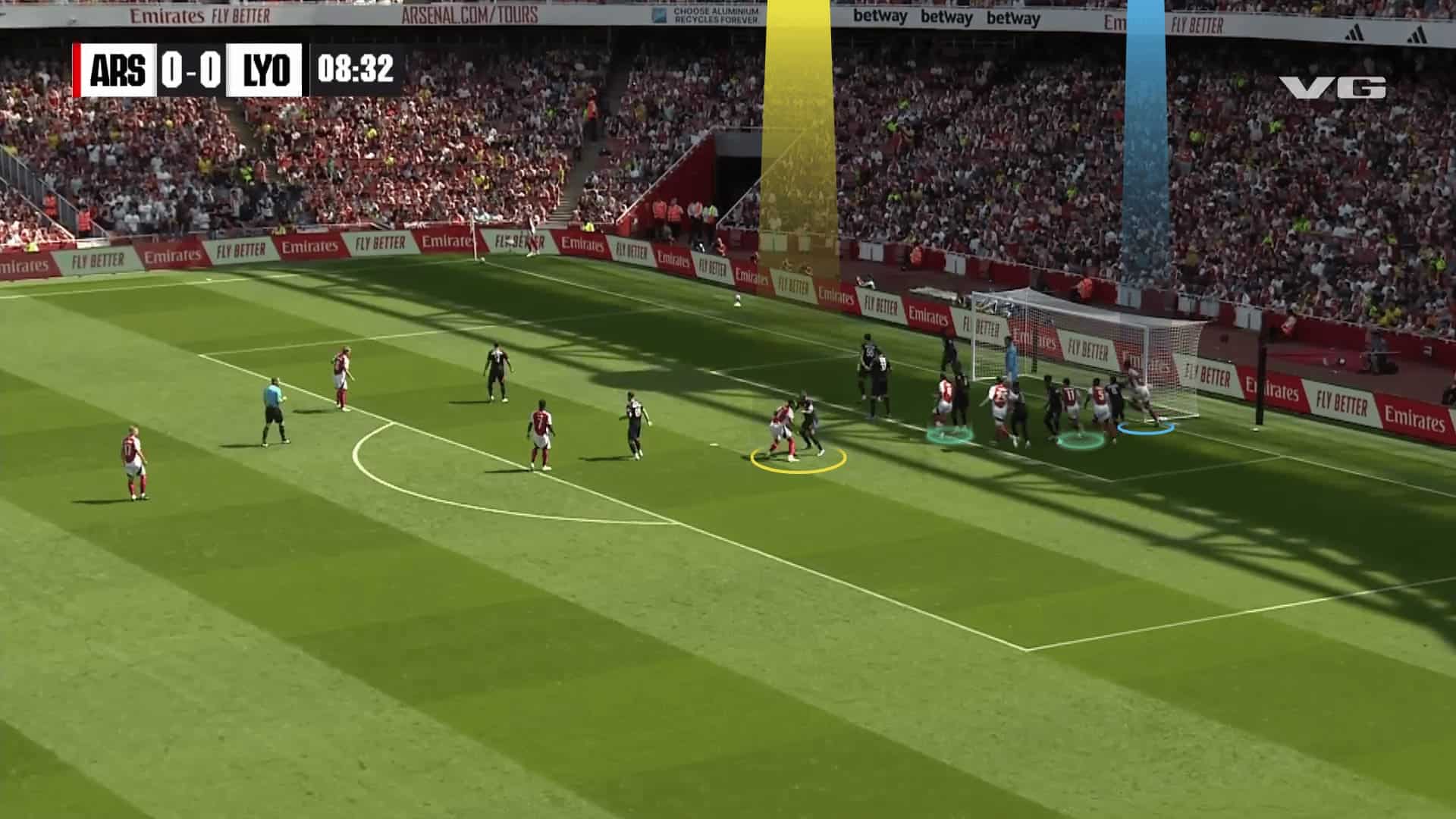
As shown below, the two green players drag the first two zonal defenders while Saliba blocks the goalkeeper so the other three players are ready to target the near-post area.
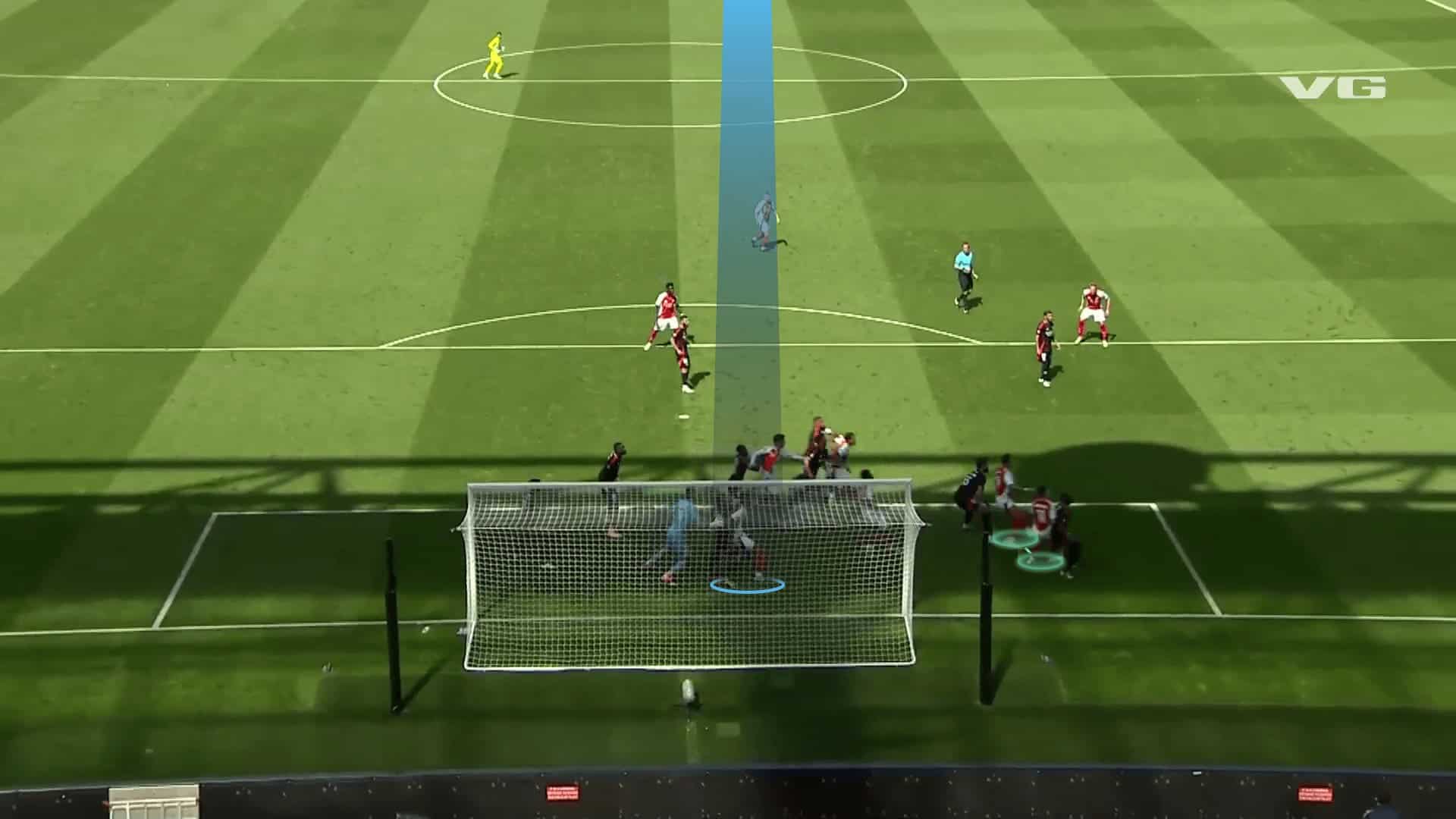
The ball is overhit, but Saliba brilliantly anticipates it and goes to the ball, scoring a goal, and that is an advantage of having players at different points of the in-swinging-cross path.
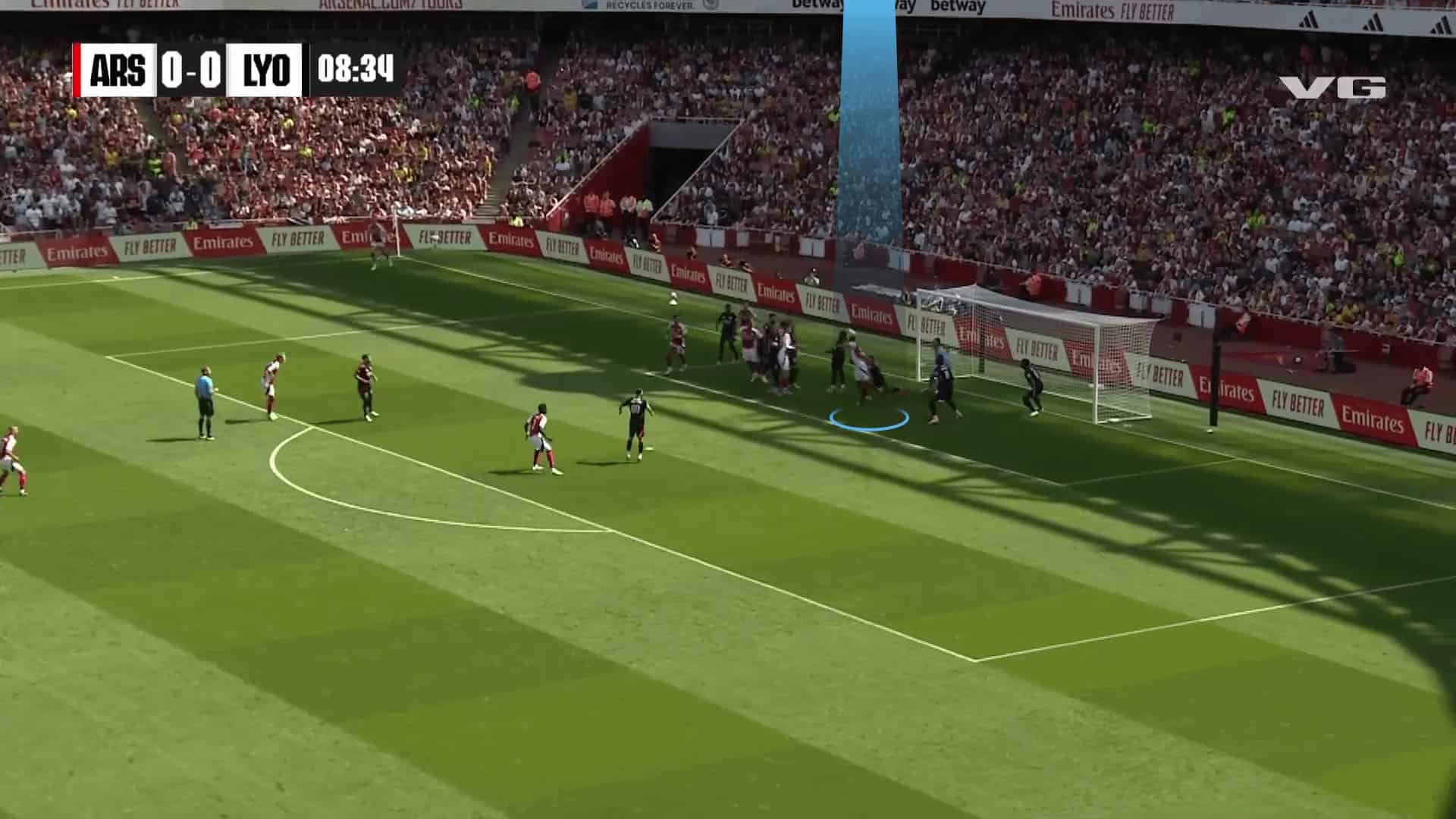
Defensively, we want to highlight that Arsenal used only three zonal defenders aligned to the goalmouth in the last match after finishing the last season using four zonal defenders.
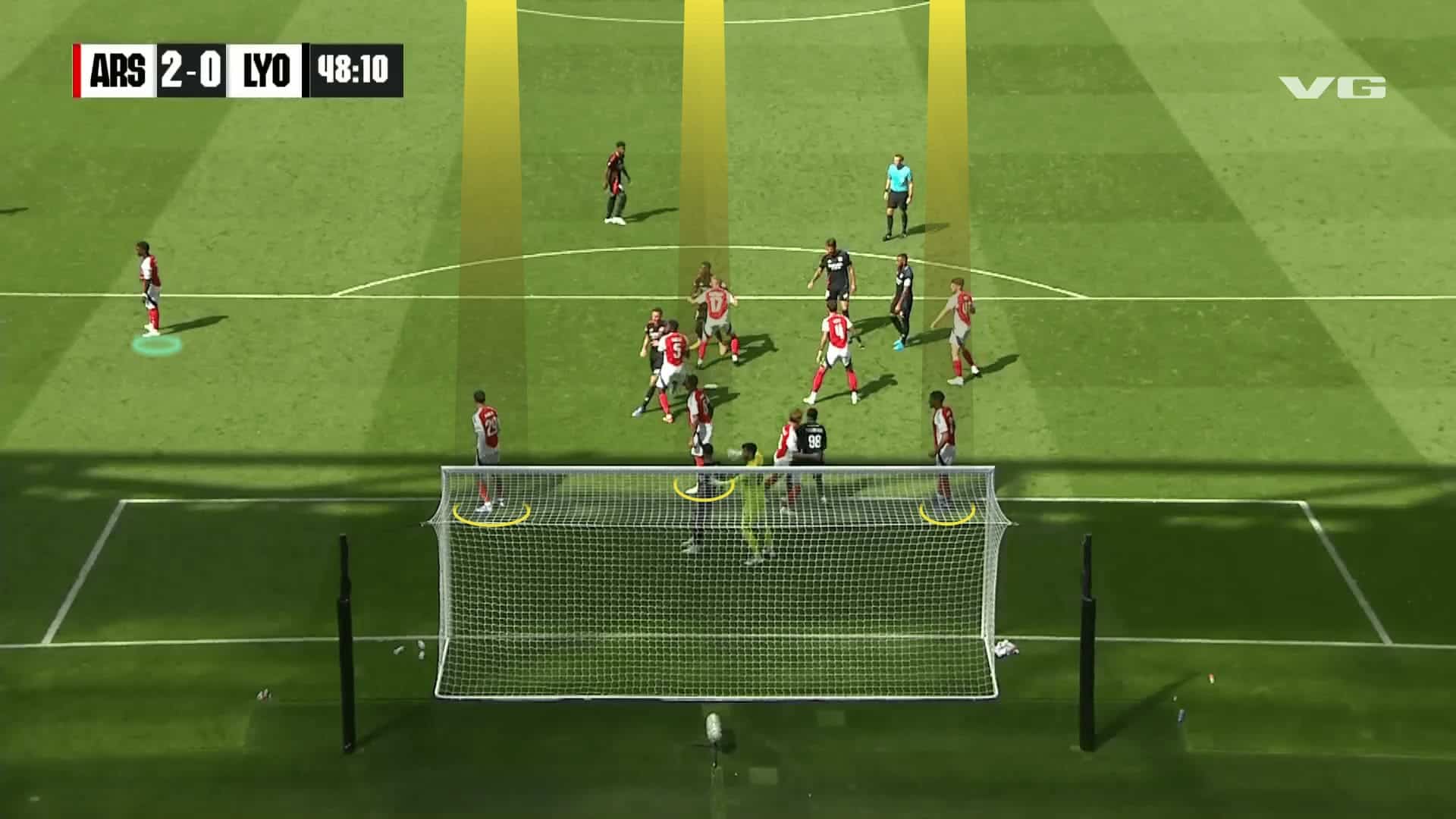
Reducing the zonal defenders increases the spaces between them, meaning they will need to shift a lot while depending more on the goalkeeper to fill these spaces.
We know that Arsenal might be betting on the quality of the goalkeeper, David Raya, and the quality of man-to-man markers, who are expected to be strong in aerial duels, especially with Riccardo Calafiori as an option.
It is personal opinions at the end, but they need to look out!
For example, You can find below their normal three zonal defenders at first, but the zonal line shifts when the opponent overloads the area before the near post and the near post.
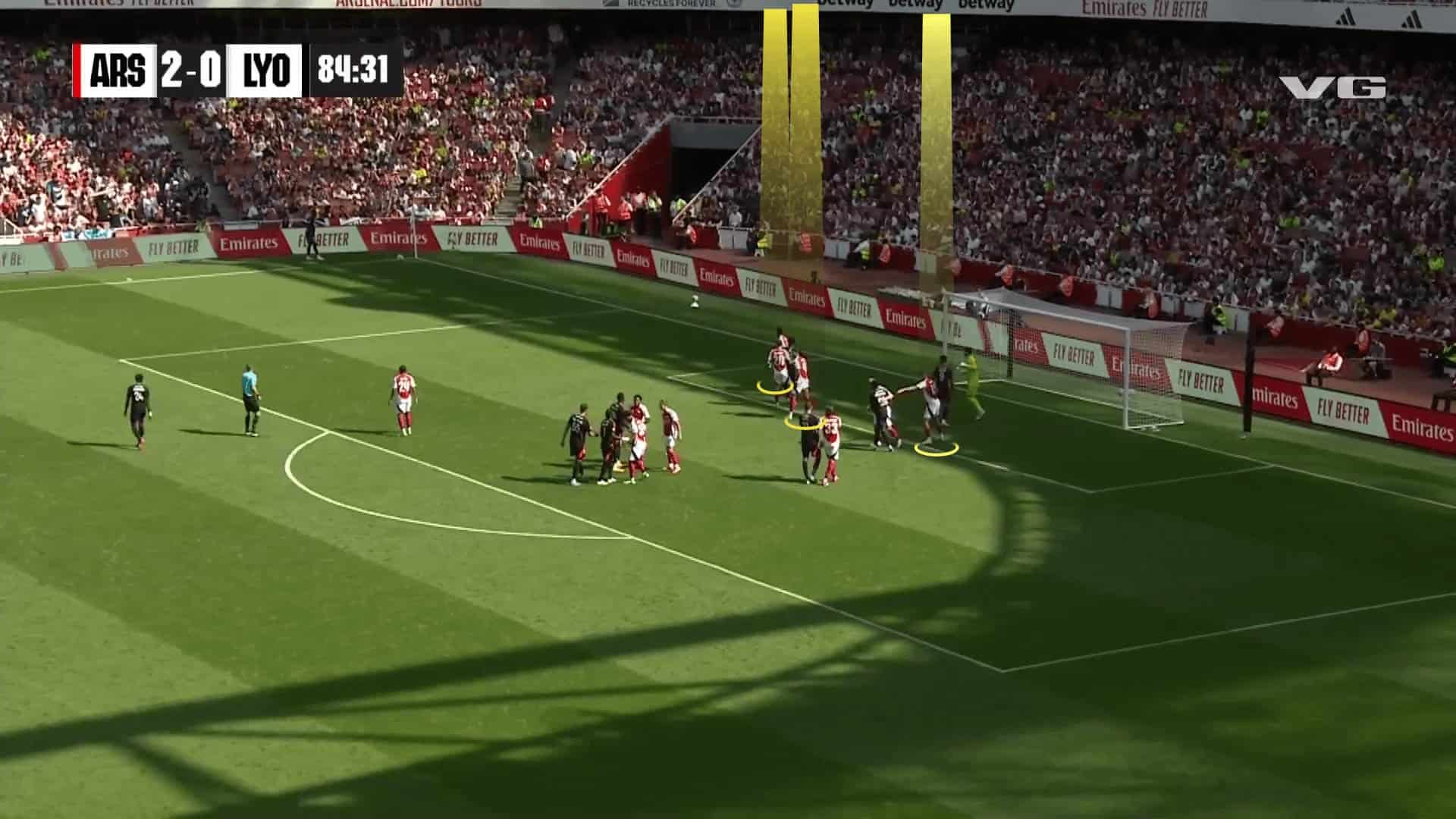
The last zonal defender becomes in the middle of the goal to fill the gaps between him and his zonal mates, which could be dangerous.
We should also mention that Arsenal is aware of that, and they even sometimes ask the three zonal defenders to stand narrowly, leaving the far post empty, trying to depend on the goalkeeper to claim the ball before going here through the six-yard or on the last zonal defender.
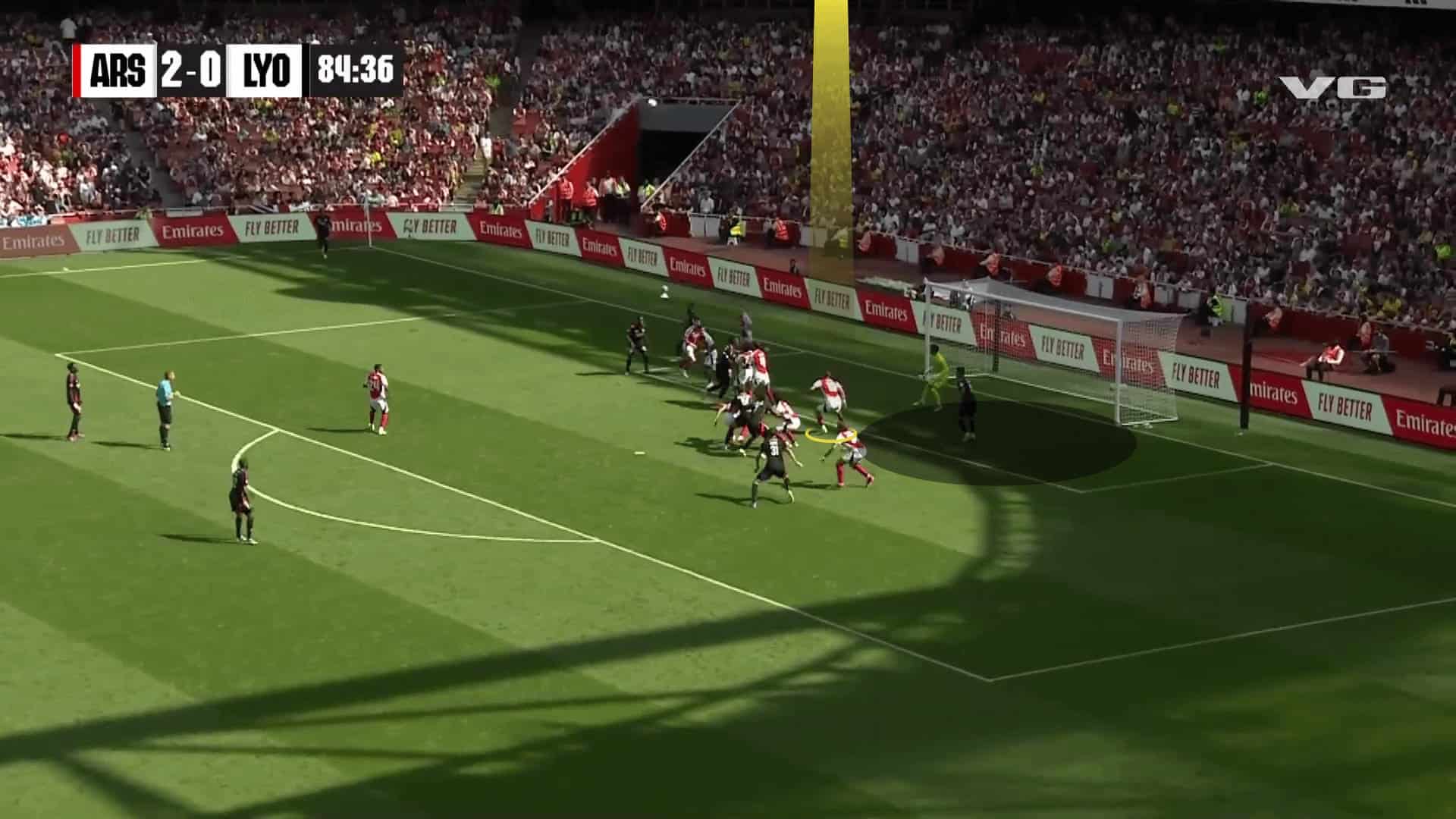
We should also mention that they started the pre-season using only two zonal defenders, and they had a weakness that could be exploited even in the three-zonal-player system: targeting the near post by an out-swing low deceiving cross.
The first zonal defender stands very high on the six-yard due to the expected out-swing path, but Man United used a player to block him while targeting a runner behind him.
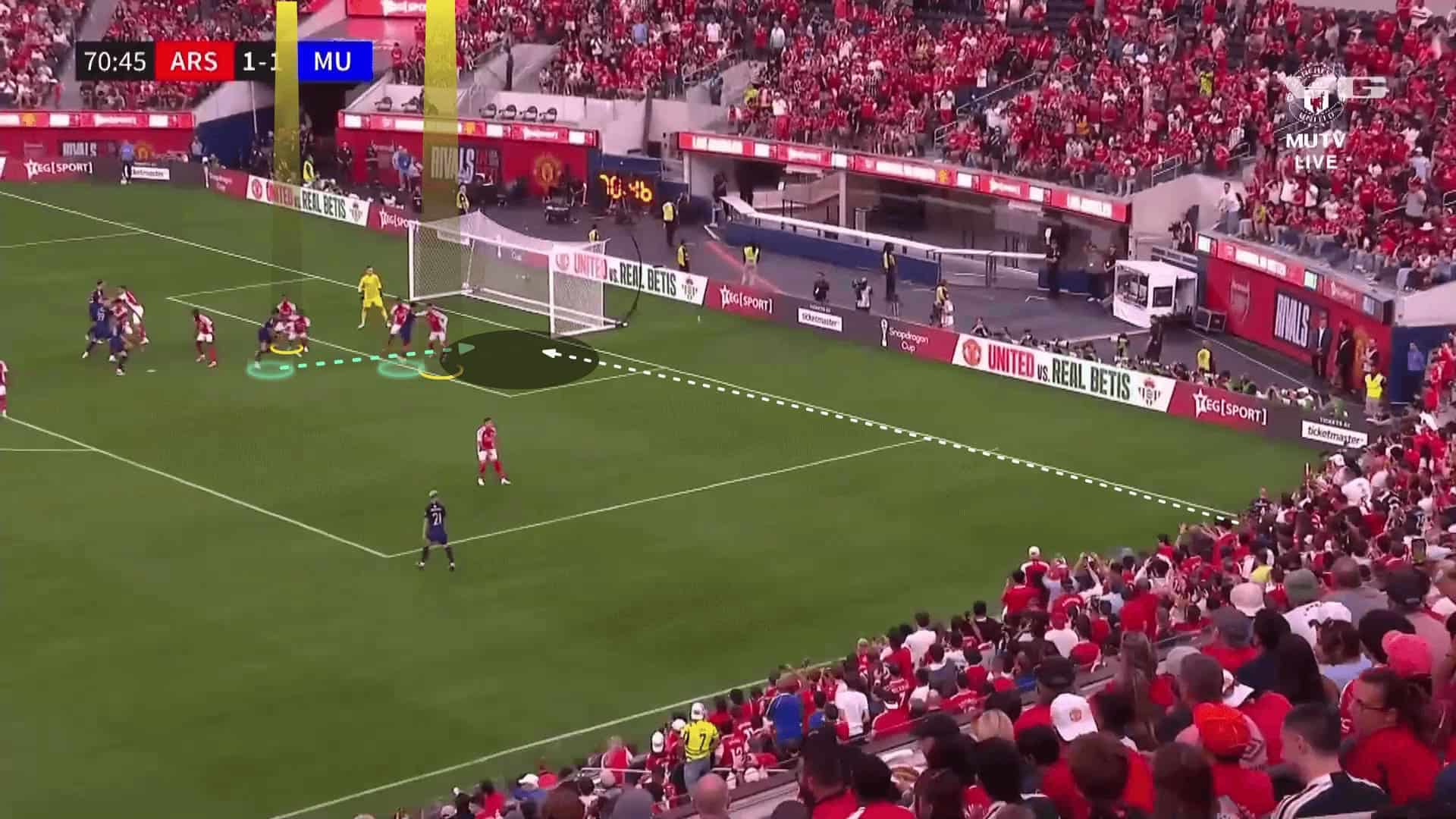
The plan works, but the ball strangely passes the attacker’s leg.
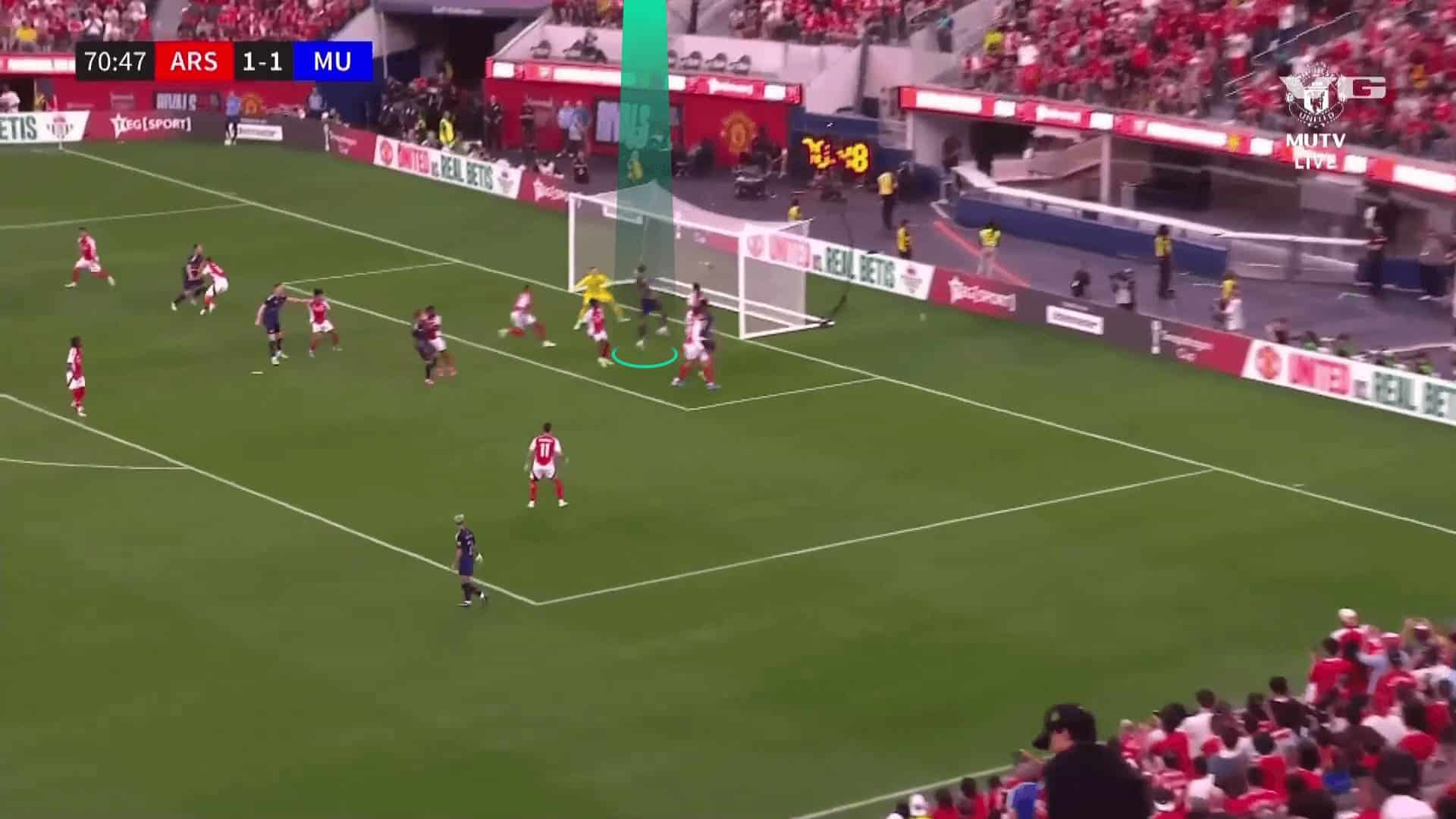
Manchester City & Tottenham Set Piece Analysis
It seems that Manchester City intend to continue on their path of interesting short corners, so they are trying to exploit the effective current trend of using overlapping, but why is overlapping useful?
In the photo below, Man City’s taker passes the ball to the close short-option player and then overlaps behind him, so it is an urgent 2-v-1 situation while the green defender who comes to help is still hesitant because he has two options:
1- Going quickly to the taker to catch him, preventing him from crossing the ball from this empty large area
2- Waiting until he becomes assured that the short-option player passed the ball and then presses the taker to cover his mate because a short-option attacker is usually a skilful player, but the taker will have the time and space to cross the ball before he comes
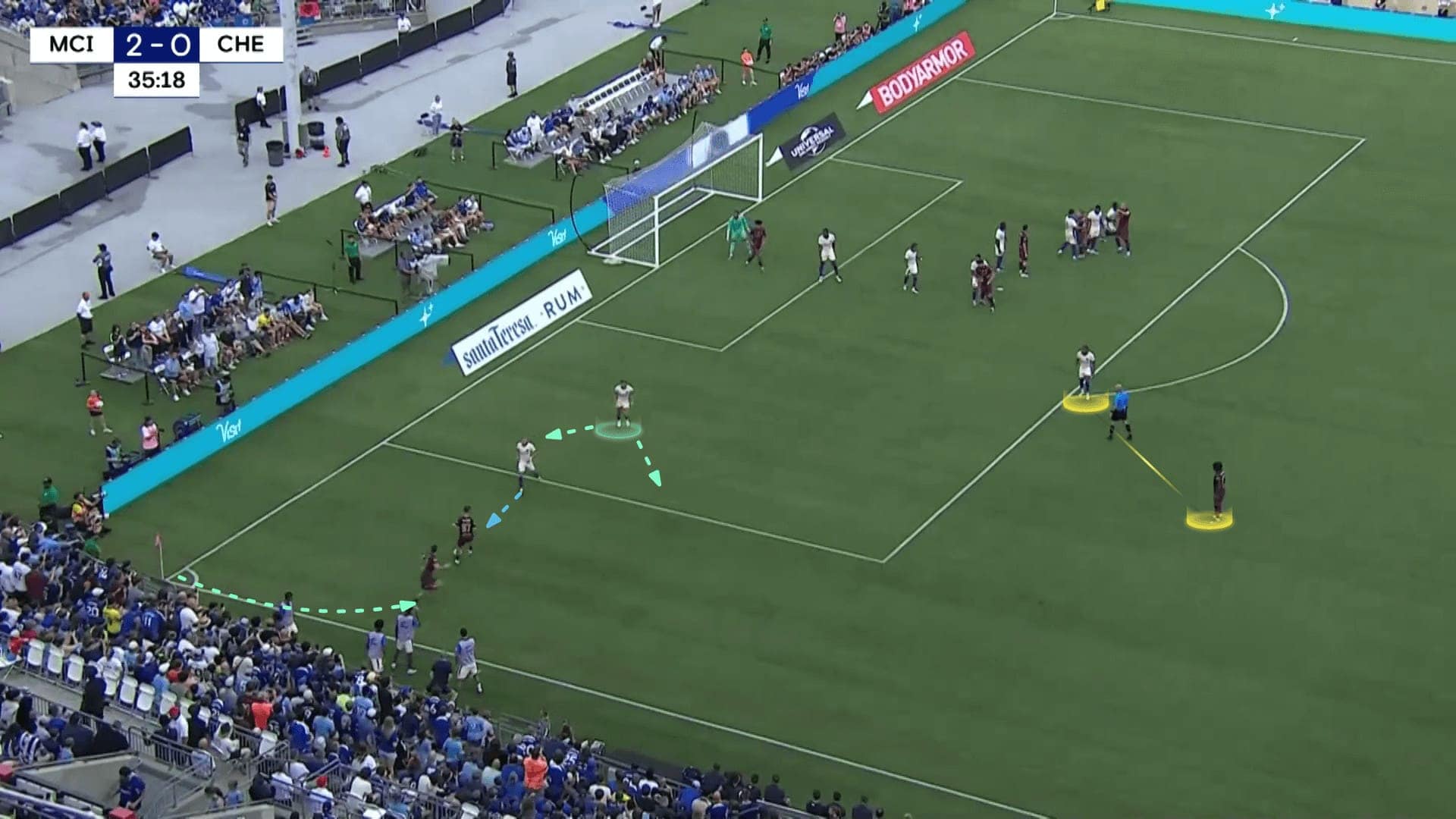
He chooses the first choice, so the short-option attacker passes the defender and has a large area to dribble and send the cross, as in the two following photos.
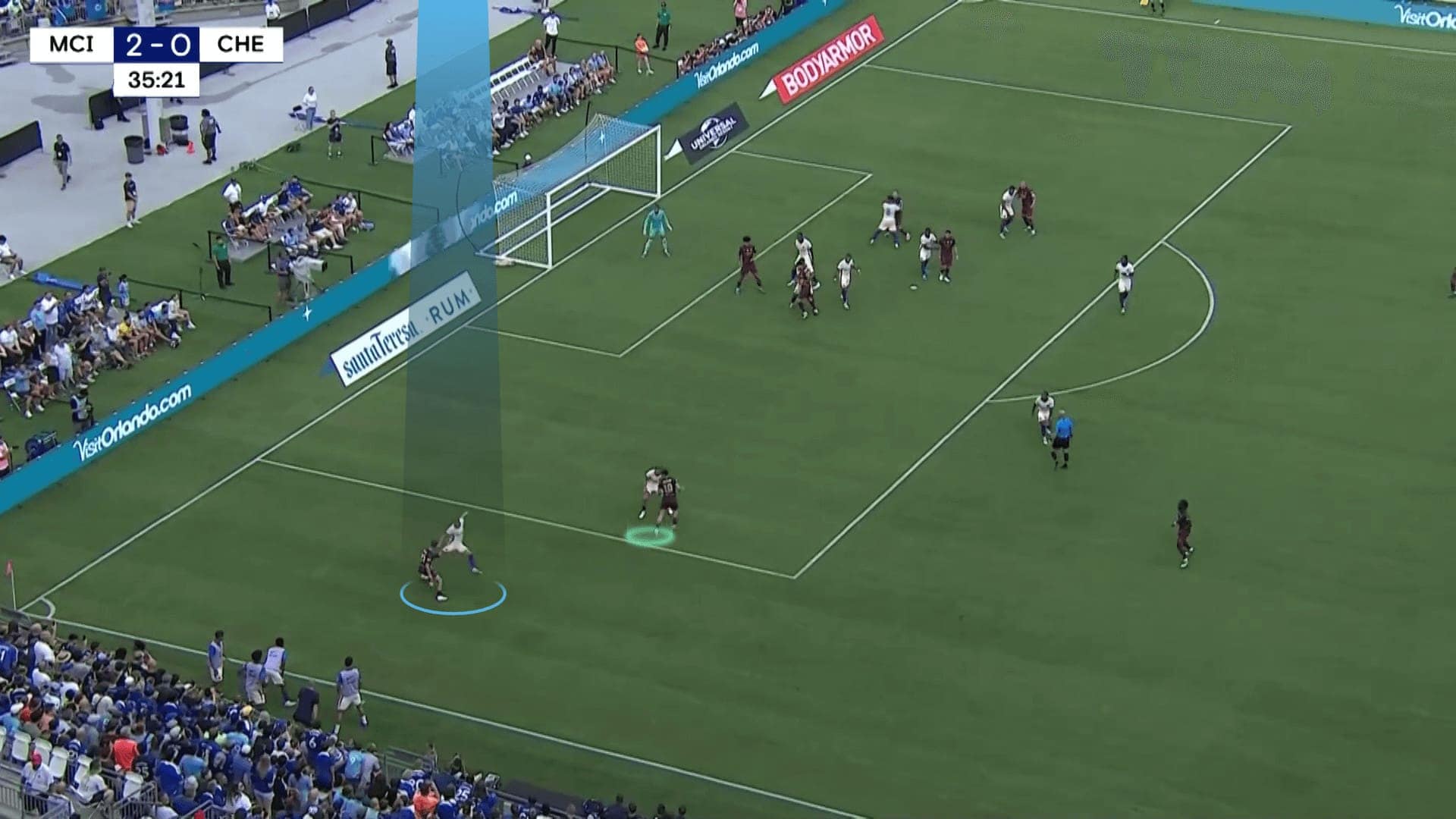
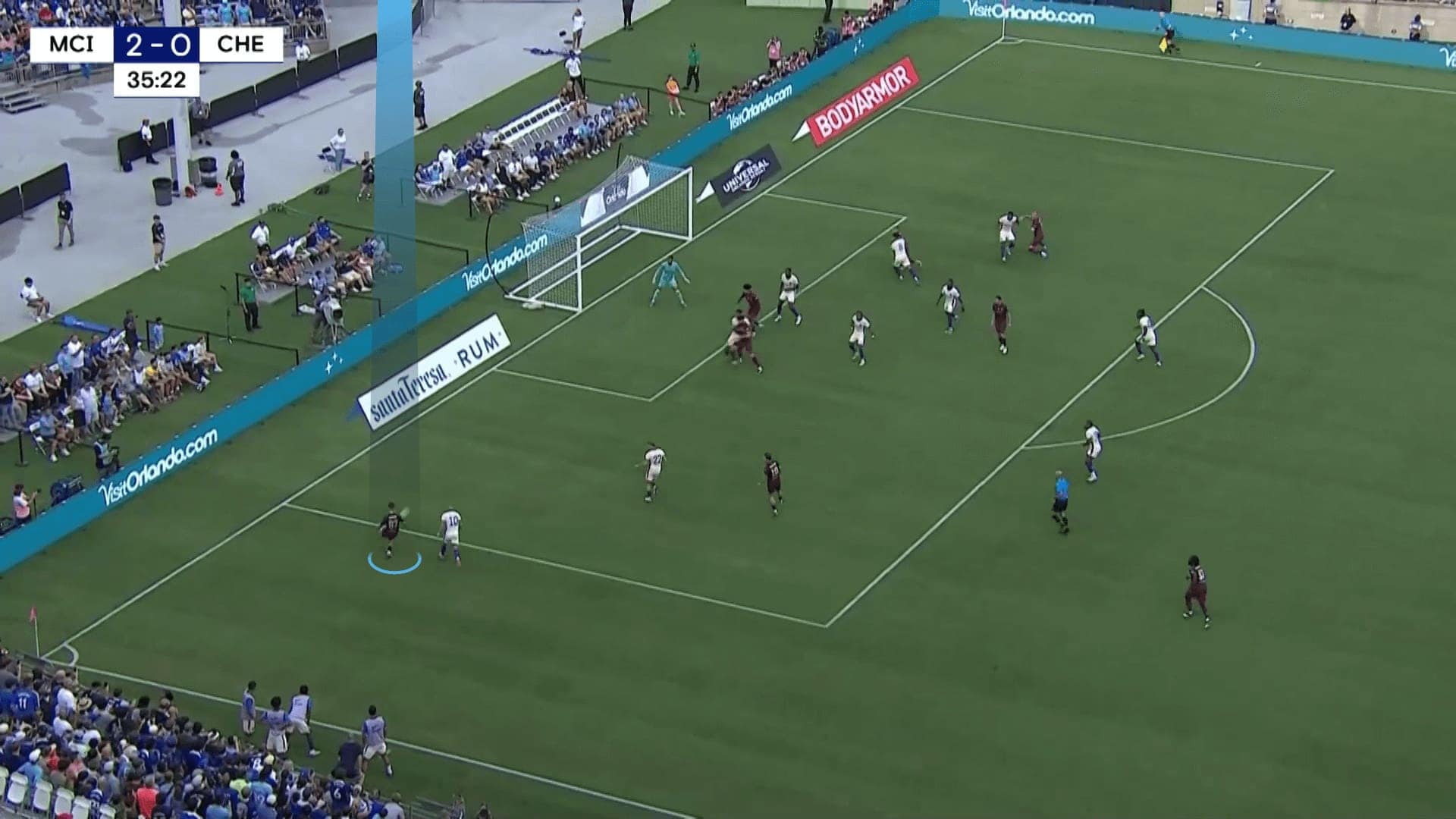
Tottenham also showed a great ability to apply the same idea while also having a good solution if the opponent increases a short defender to two short-option defenders from the beginning.
As in the photo below, they simply increase a second short-option attacker on the corner of the box, but what will be his role?!
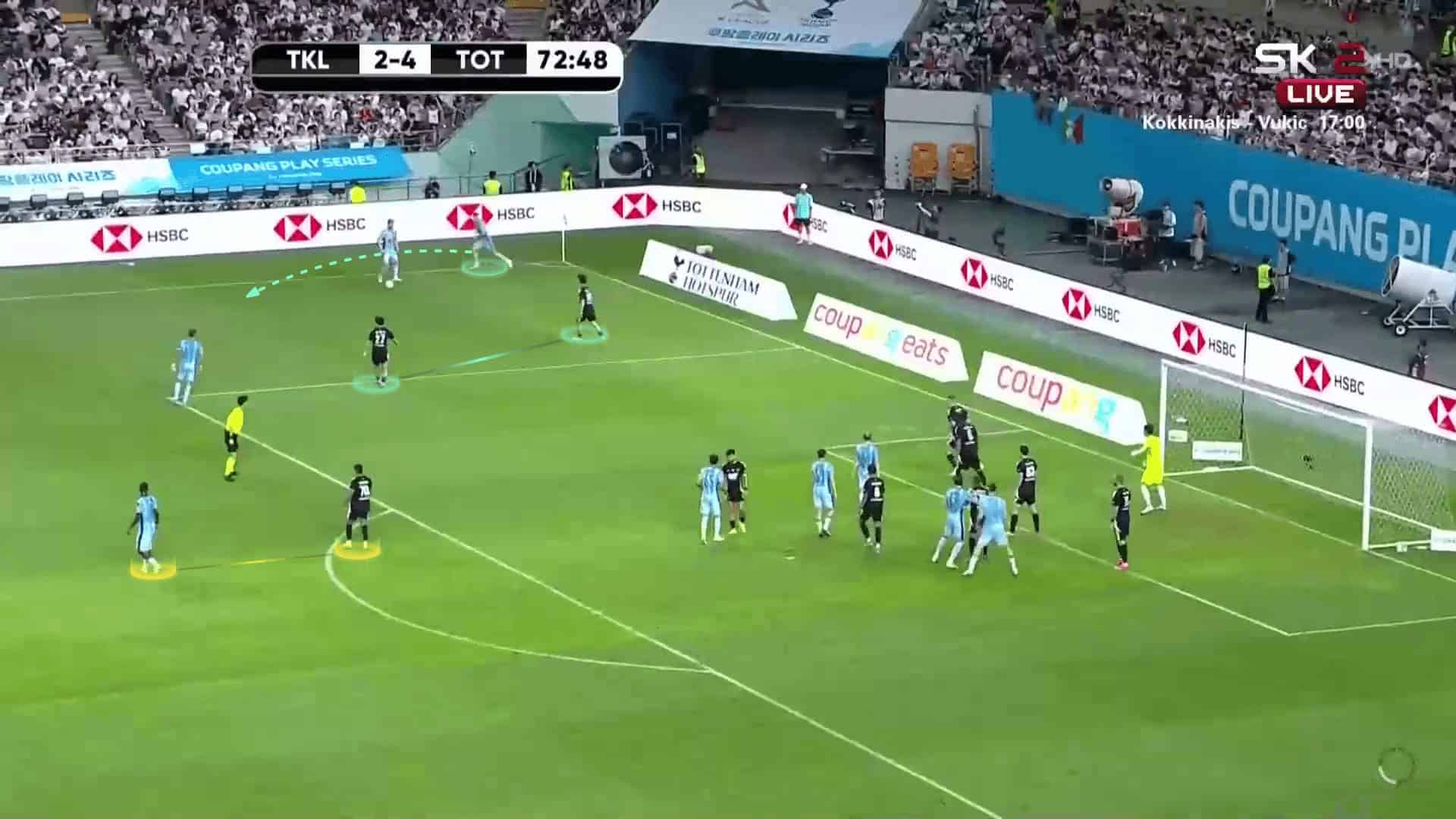
His role is to ask the second-option defender a difficult question: Will you be dragged with me to cover the area behind you in the box, or will you be stuck with your role of pressing the taker after overlapping?
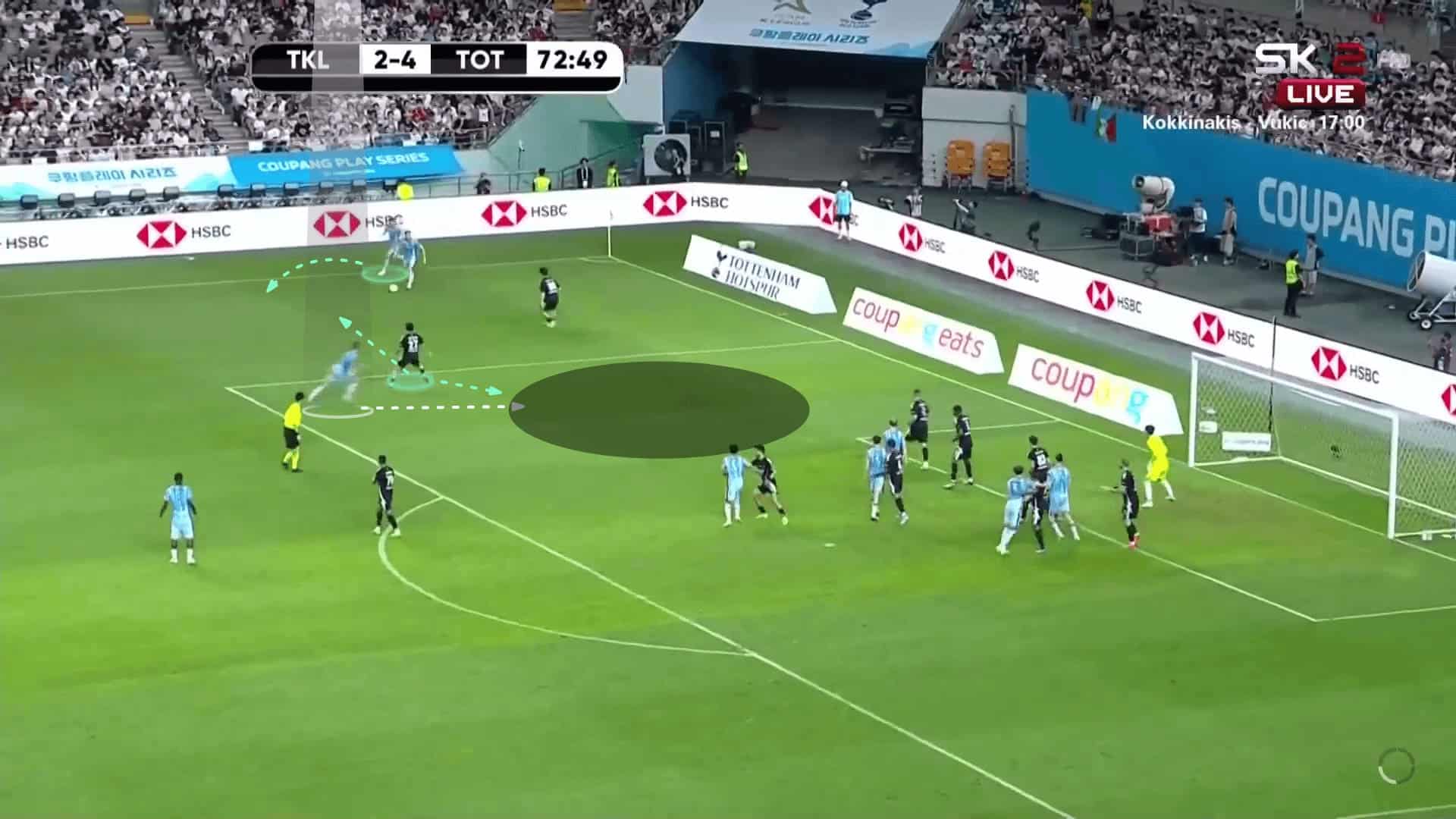
The plan works, and he receives the ball in the area behind him, ready for a dangerous cut-back pass, as shown below.
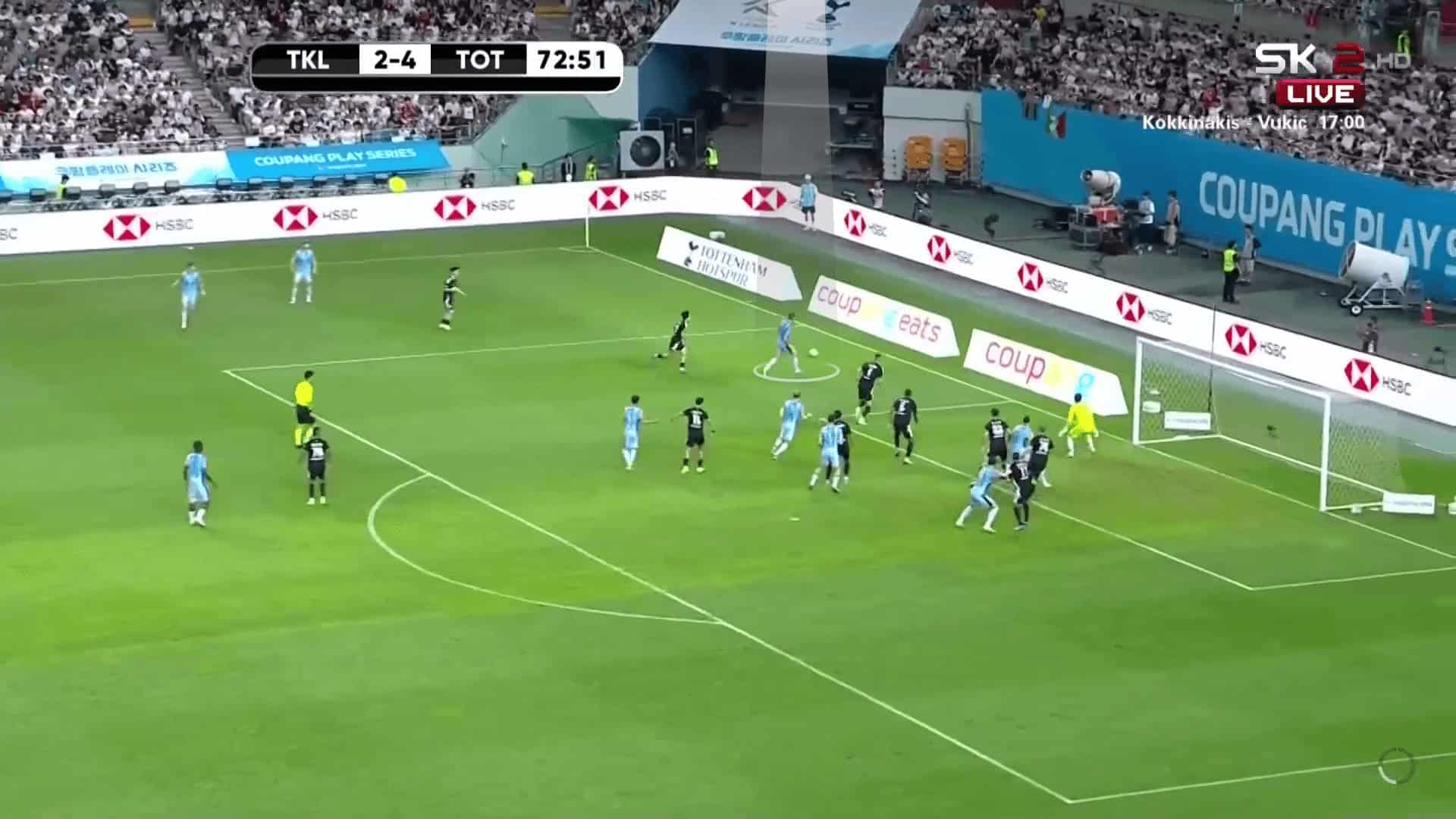
Conclusion
In this Premier League set piece analysis, we have dissected what we think teams will try to do during set-pieces during this upcoming Premier League 2024/2025 season, showcasing the new ideas and trends that teams have been trying out during the pre-season.
By examining various teams’ approaches to set pieces in the pre-season, it becomes evident that there is a significant focus on innovation and adaptability in set-piece execution.
As the 2024/2025 Premier League season progresses, it will be interesting to see how these pre-season tactics are refined and adapted in response to competitive challenges.

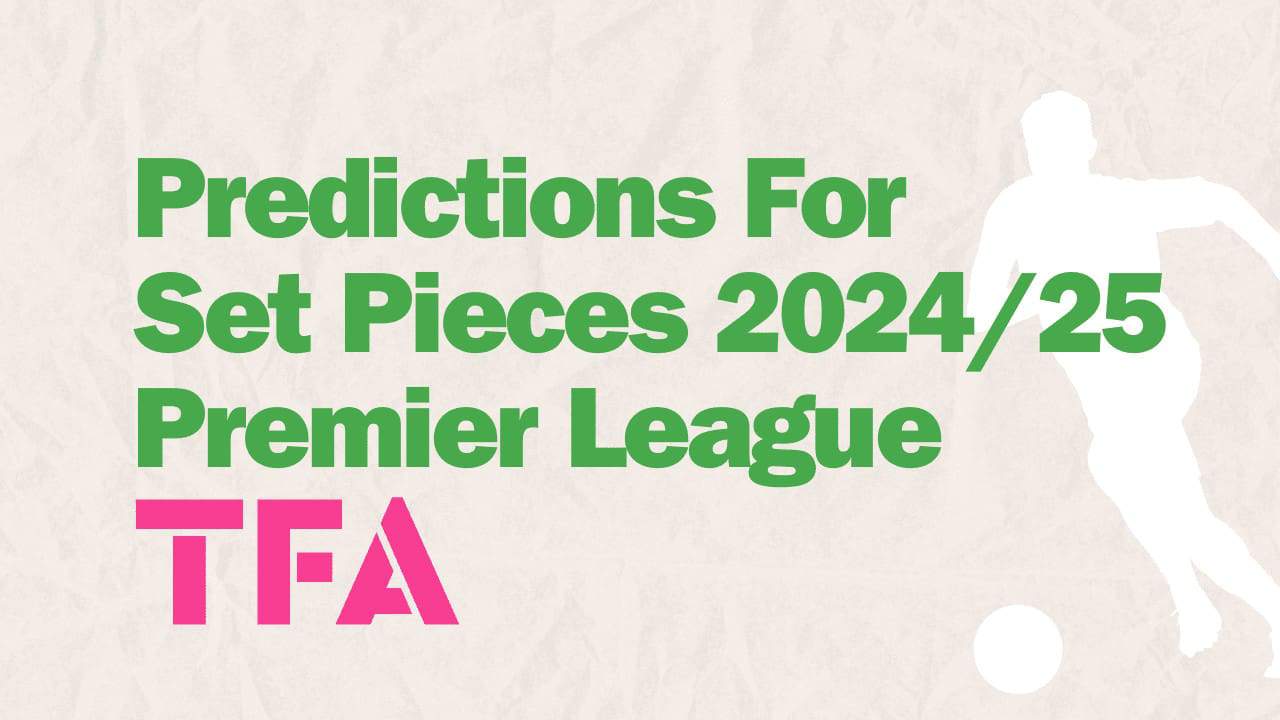




Comments